December 17, 2022
Welcome to Berlin’s Tempelhof Airport, where today in Microsoft Flight Sim I will be flying the Junkers Ju 52, one of the world’s first modern airliners, which became an icon of the Nazi regime.
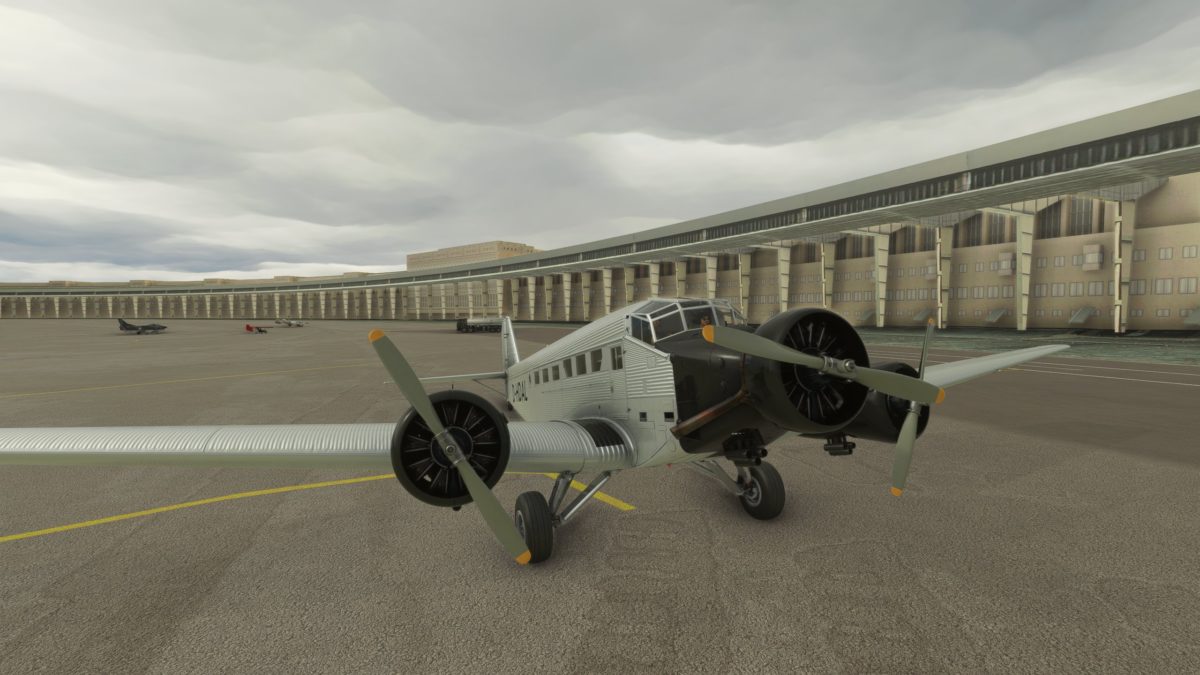
Tempelhof was Berlin’s main airport from 1927 to the 1970s, and was a main site of the 1948 Berlin Airlift. I have a whole post here on my visit to Tempelhof (now closed), and its history.
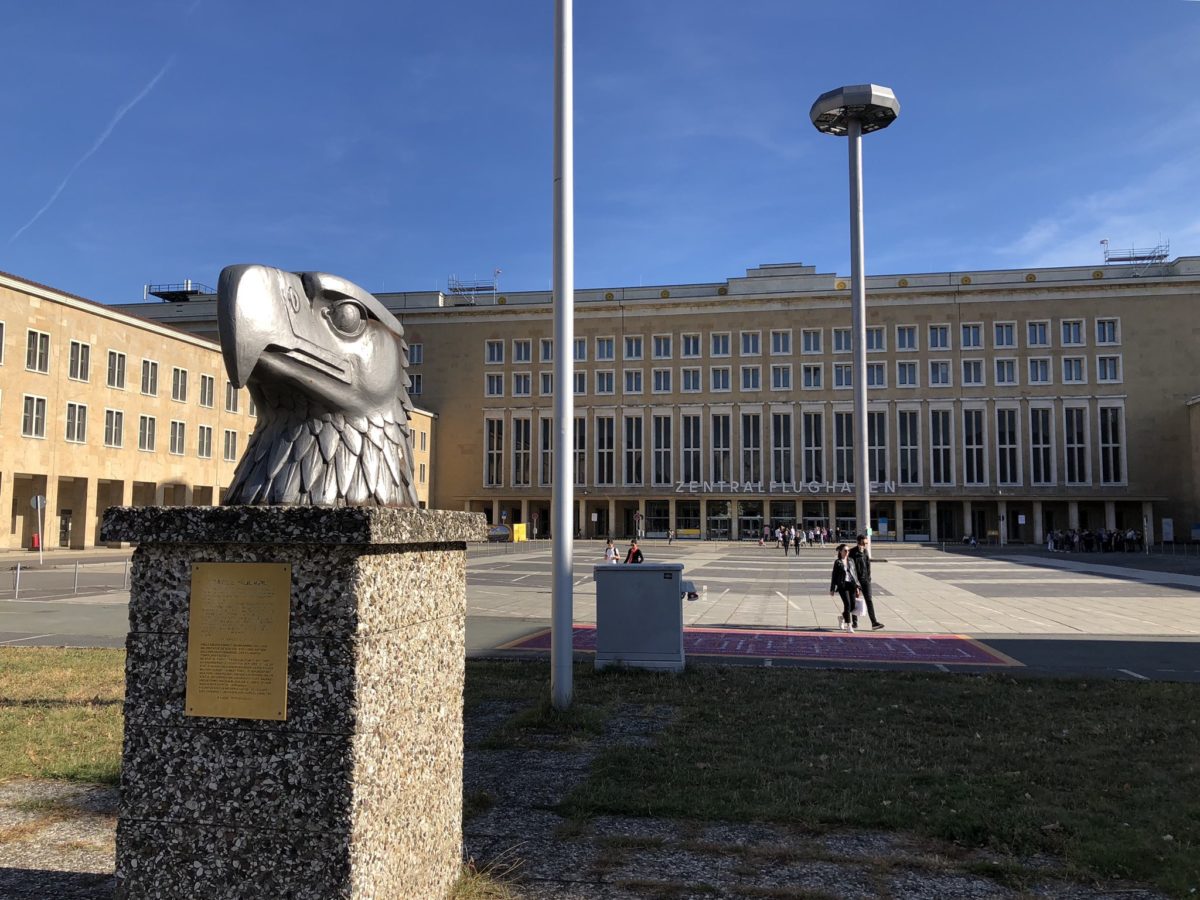
The Junkers Ju 52 was first introduced in 1931. The original prototype had a single engine in the nose, but for safety, the design was soon converted to a trimotor configuration.
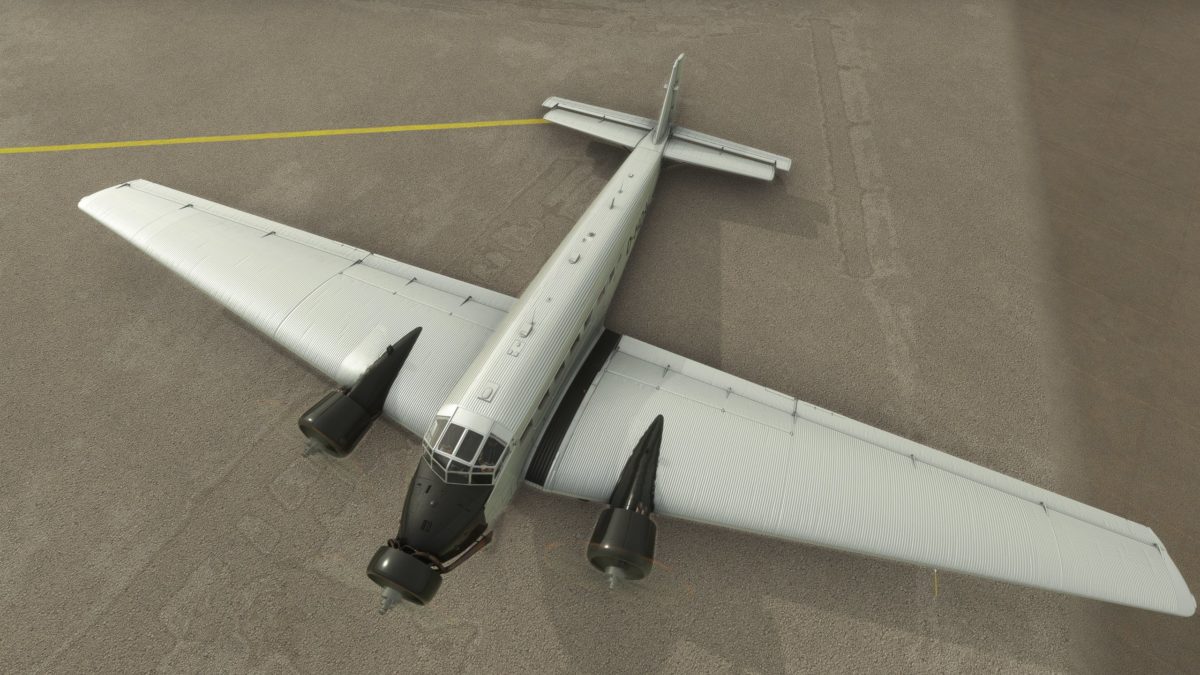
The airplane accommodated 17 passengers in what for the time was unprecedented comfort.
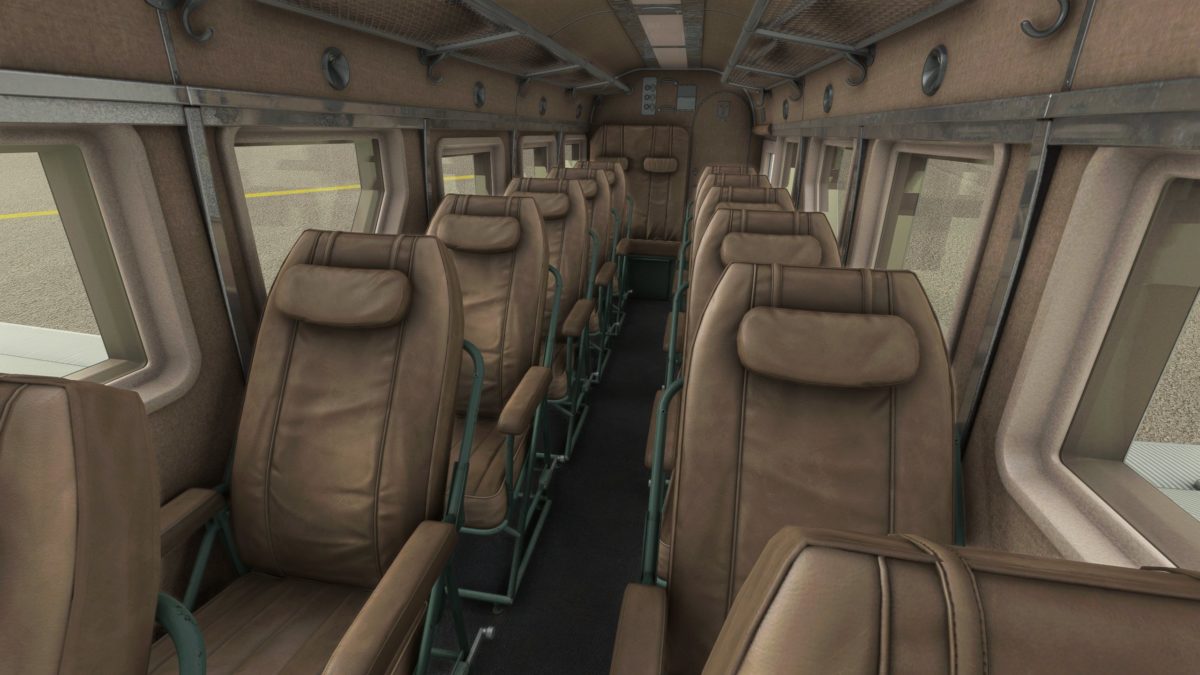
The Ju 52 was powered by three BMW 132 9-cylinder radial engines, each producing 950 horsepower. The landing gear were fixed and did not retract.
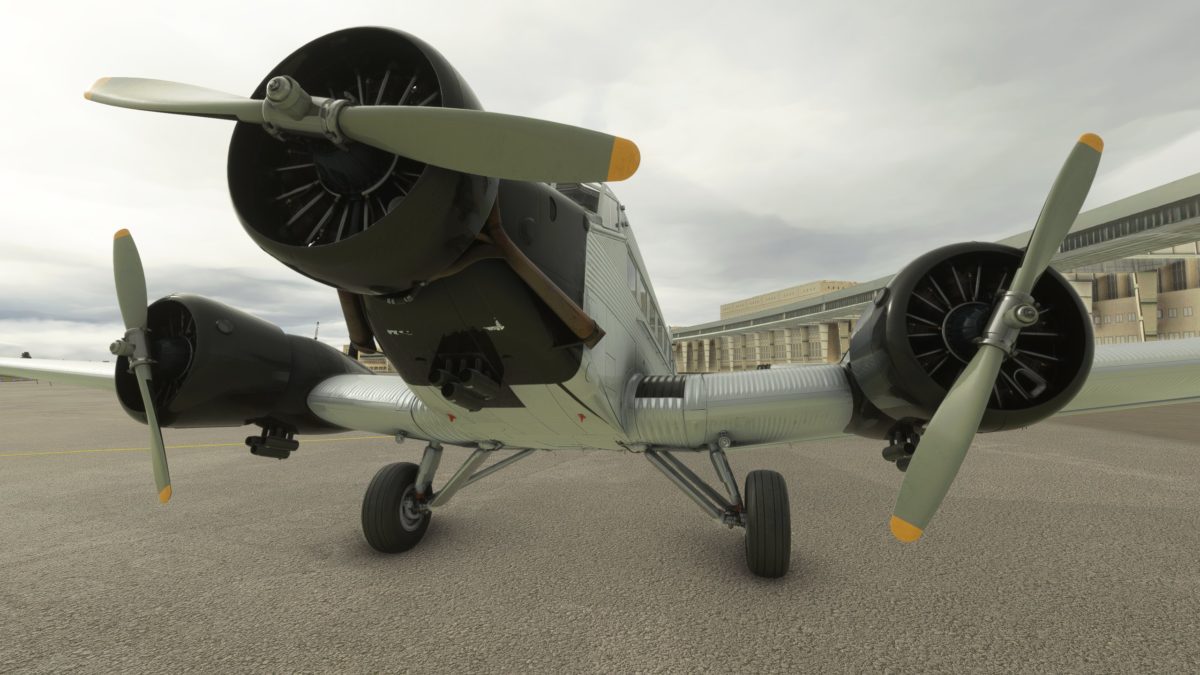
The engines consumed – and leaked – a huge amount of lubricating oil. When mechanics climbed up to service the plane, they had to be careful not to slip on its often grease-coated surface.
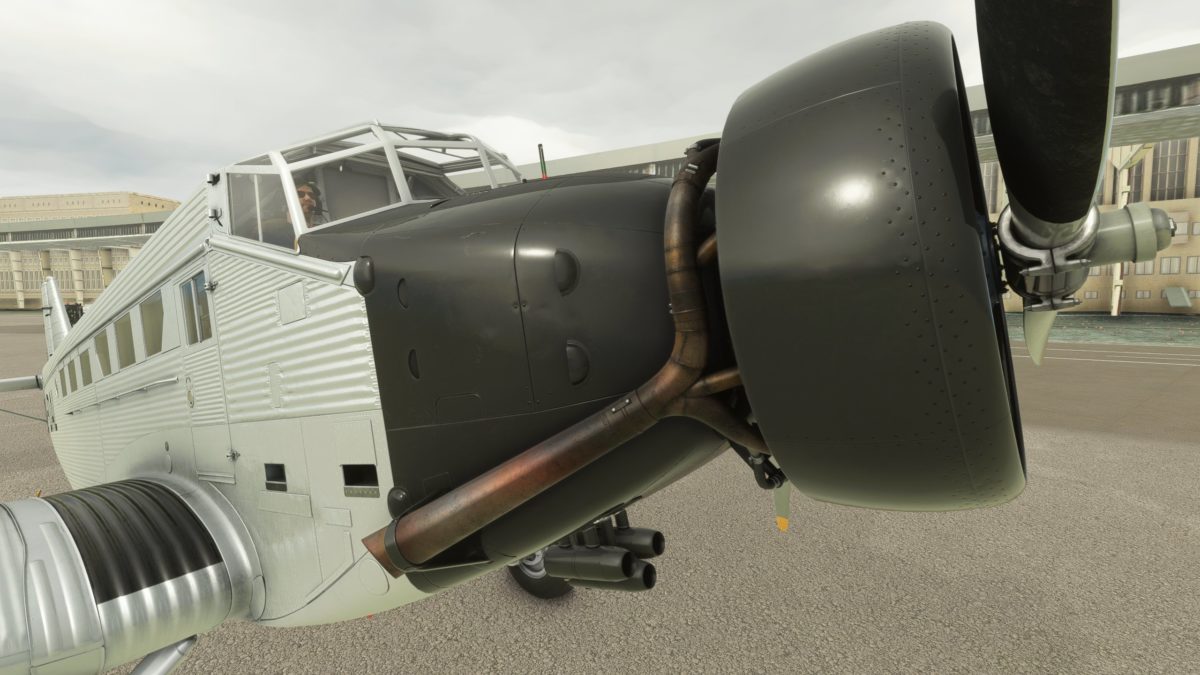
Hugo Junkers was a pioneer in introducing all-metal aircraft. One of the most distinctive features of the Ju 52 is its corrugated wings and fuselage, made of a new aluminum-copper alloy called duralumin.
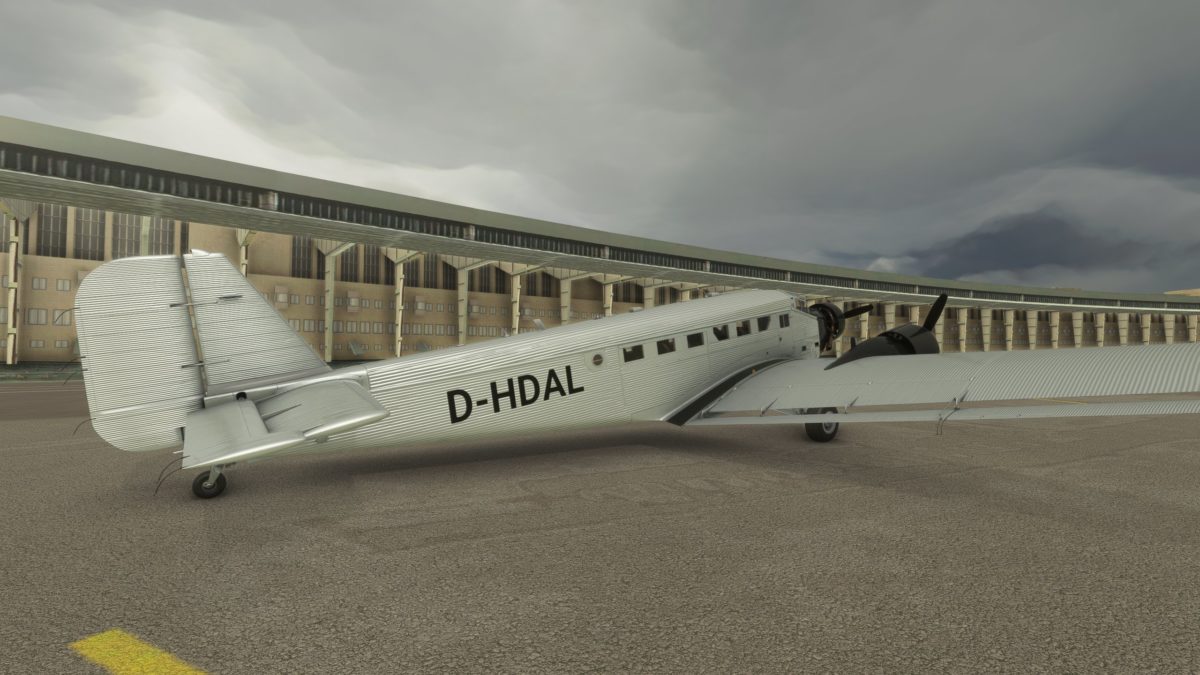
The corrugated duralumin gave the Ju 52 great strength at a lighter weight. However, it also created a huge amount of drag, which took every effort of the three engines to overcome.
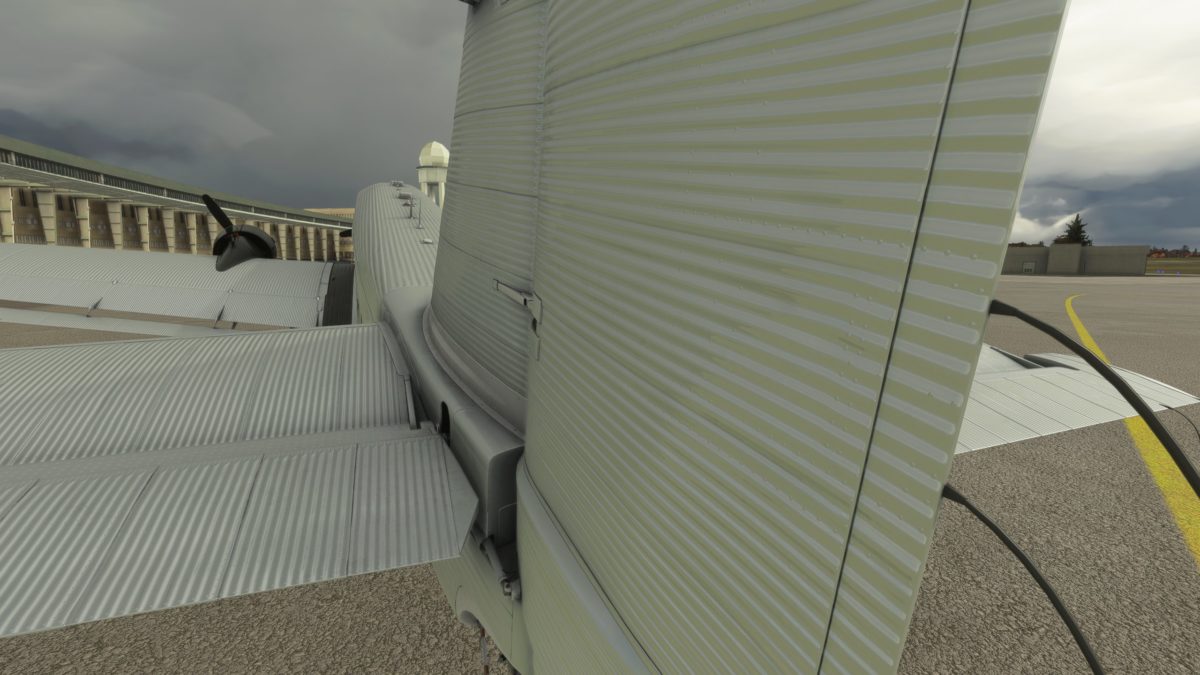
Another notable feature of the Ju 52 was its Doppelflügel, or “double wing”, an extended flap along the trailing edge of its entire main wing which significantly lowered its stalling speed.
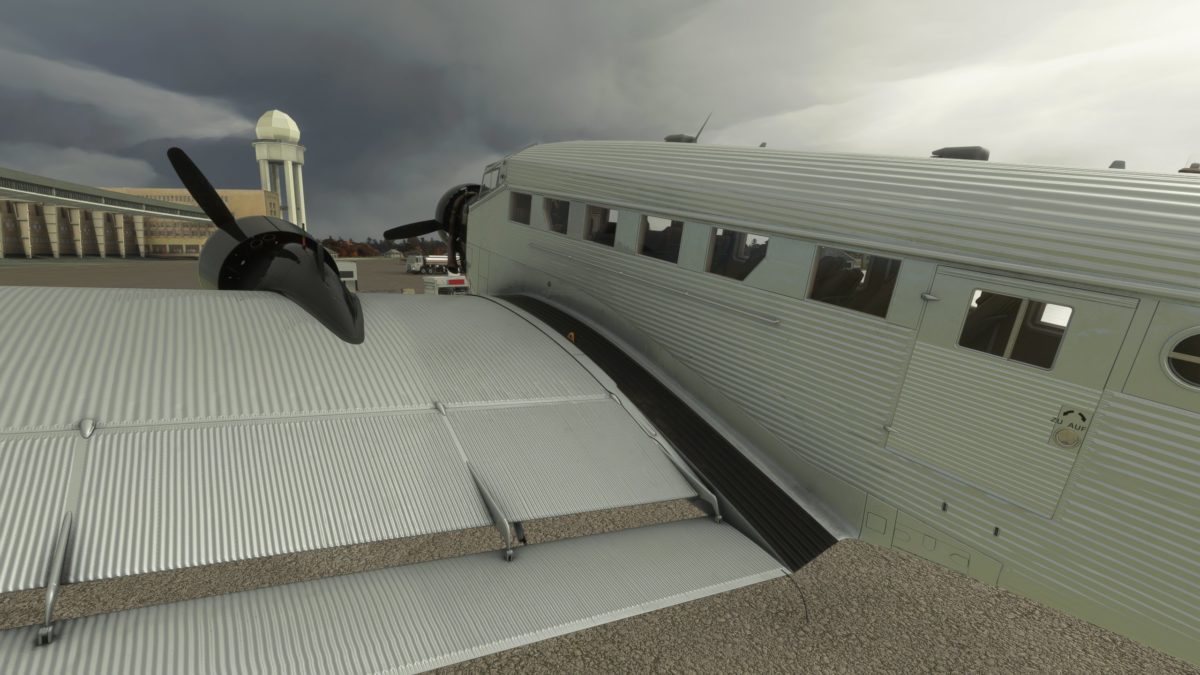
Please relax and take your seats as we prepare to start the engines.
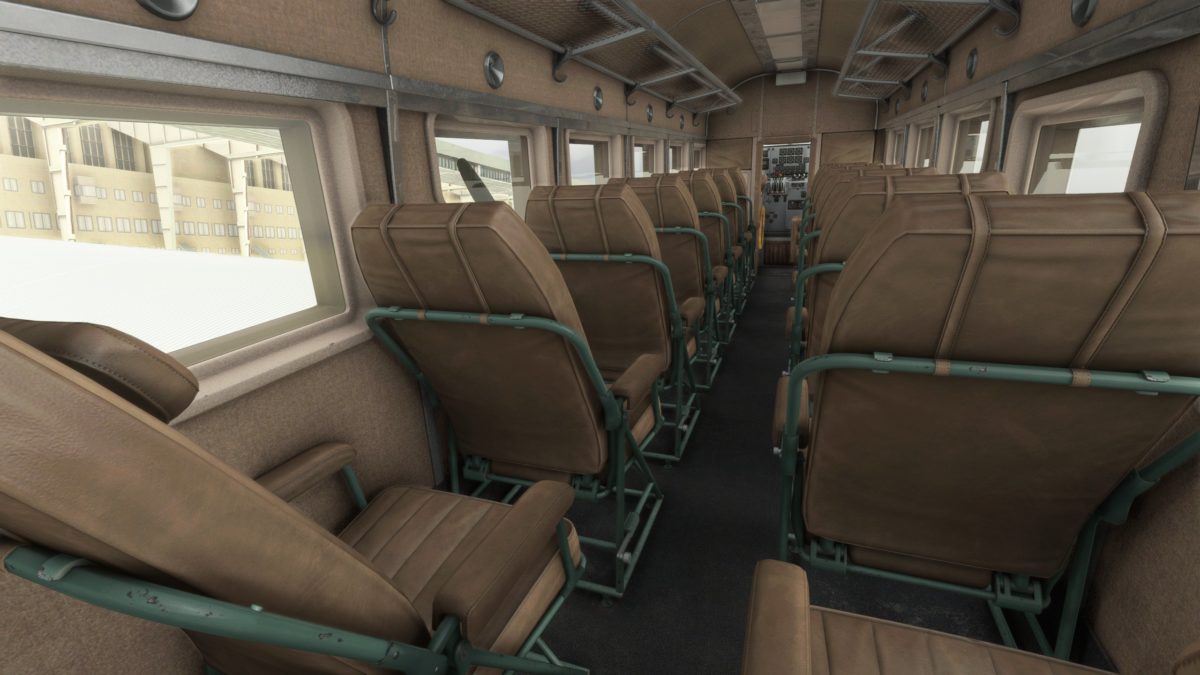
The Ju 52 is flown by a pilot (left) and a co-pilot (right) whose main job is to monitor the status of the engines and make necessary adjustments.
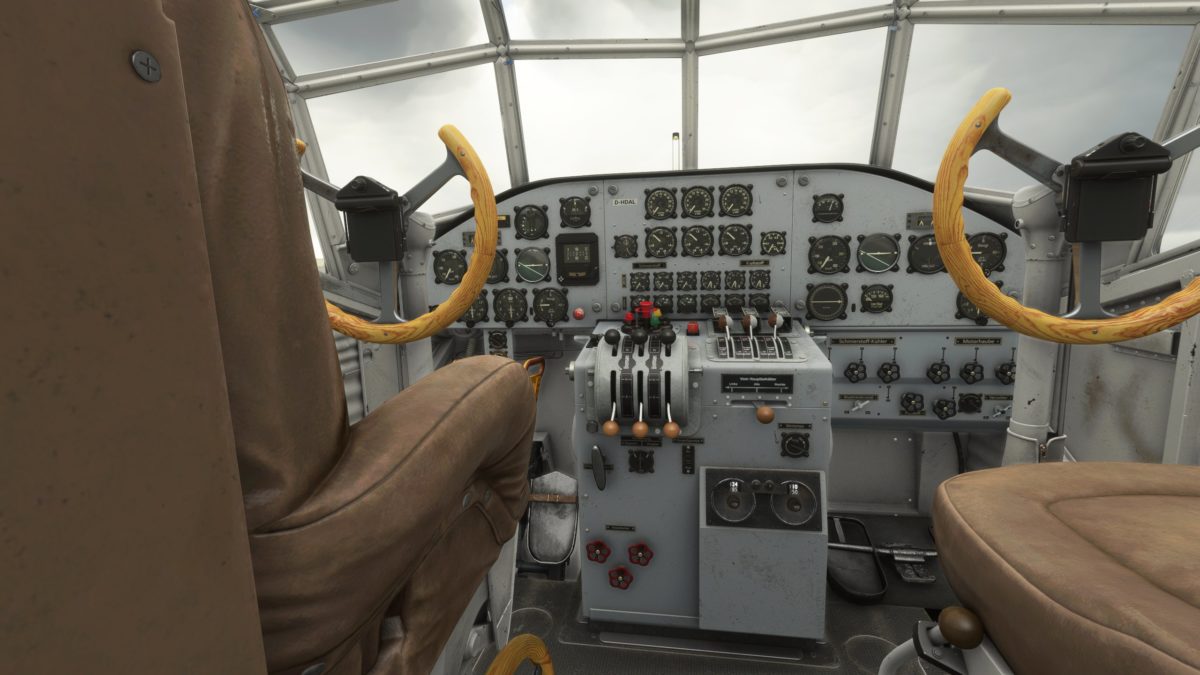
There are three throttles and three mixtures controls, one for each engine, which are started separately.

Interestingly, the third set of levers, on the upper right, is not for adjusting the propeller, which has a fixed pitch, but for regulating the amount of oil to the engines. As I mentioned, these engines just guzzled oil.
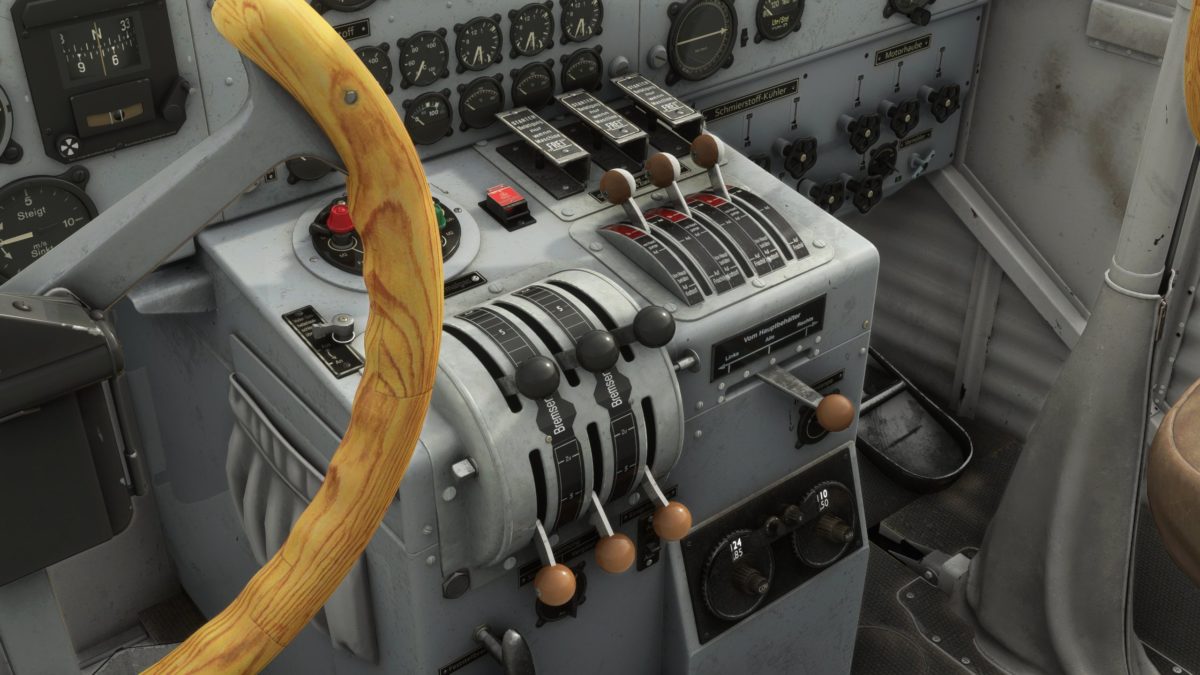
The two yellow handles in front of the pilot’s yoke are for trimming the rudder left or right, in addition to controlling them directly via the rudder pedals.
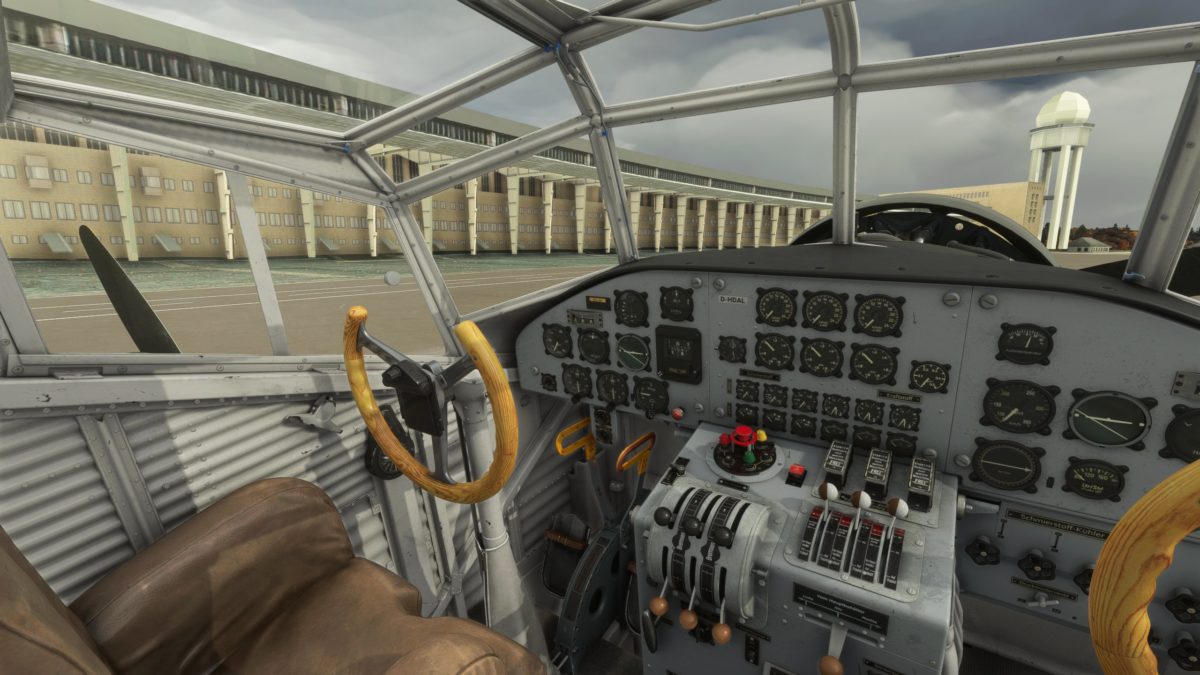
All three engines are started and its time to taxi to the runway.
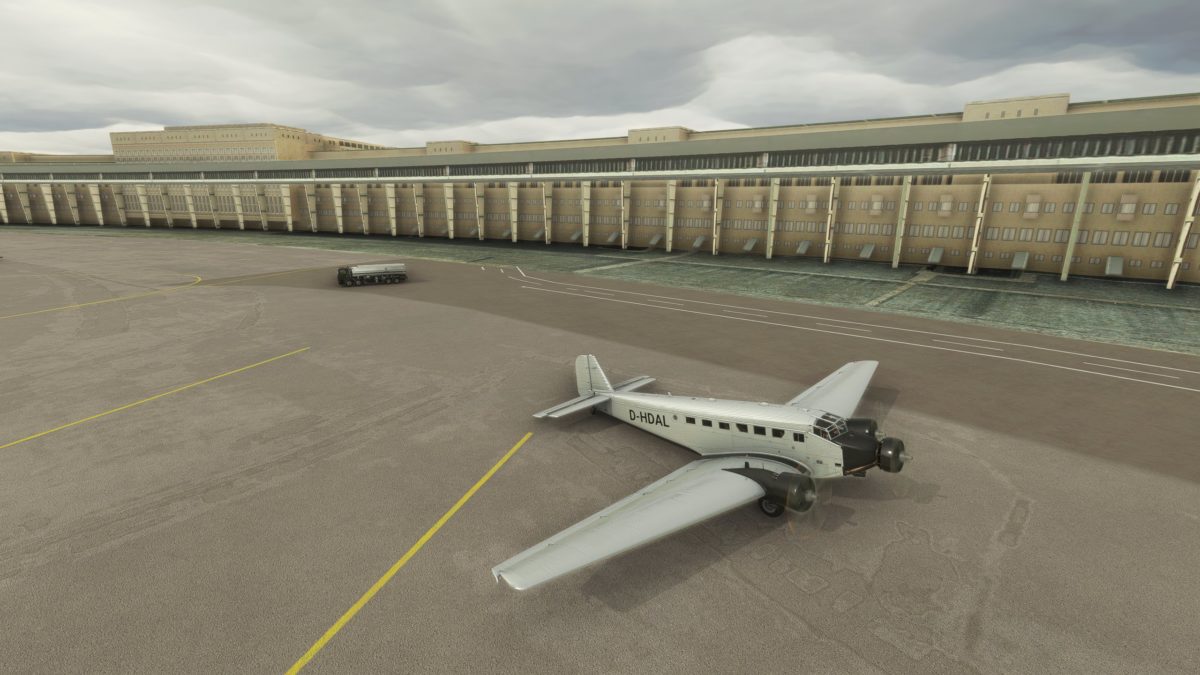
These days, Tempelhof is a park. When I was there, they were having a kite festival.
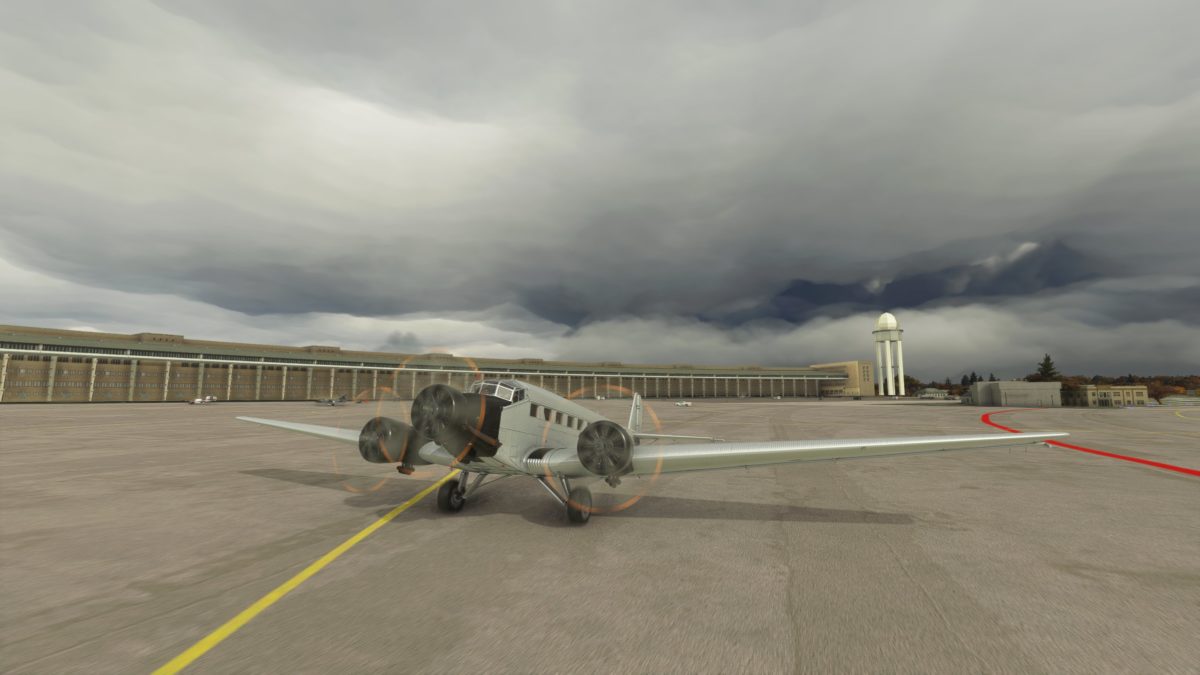
The Ju 52, nicknamed the Tante Ju (“Aunt Ju”), had the range to reach destinations like Stockholm and even Rome for the first time.
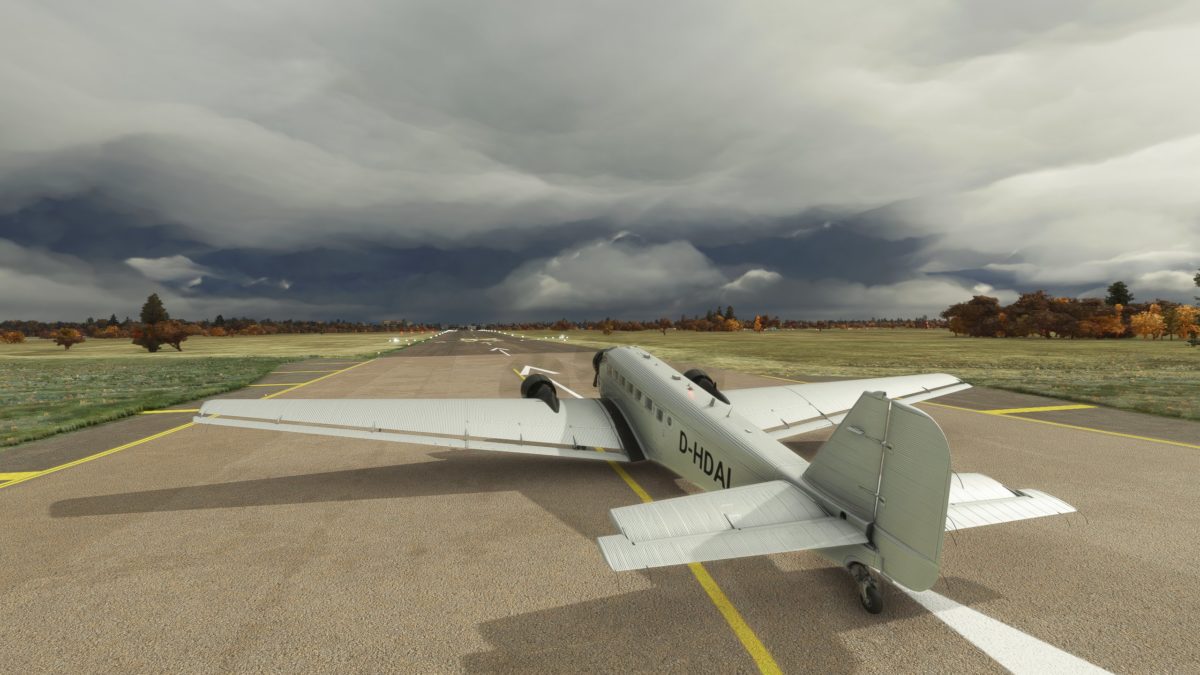
With the flaps down the recommended 25 degrees, the Ju 52 leapt off the runway in a very short distance.
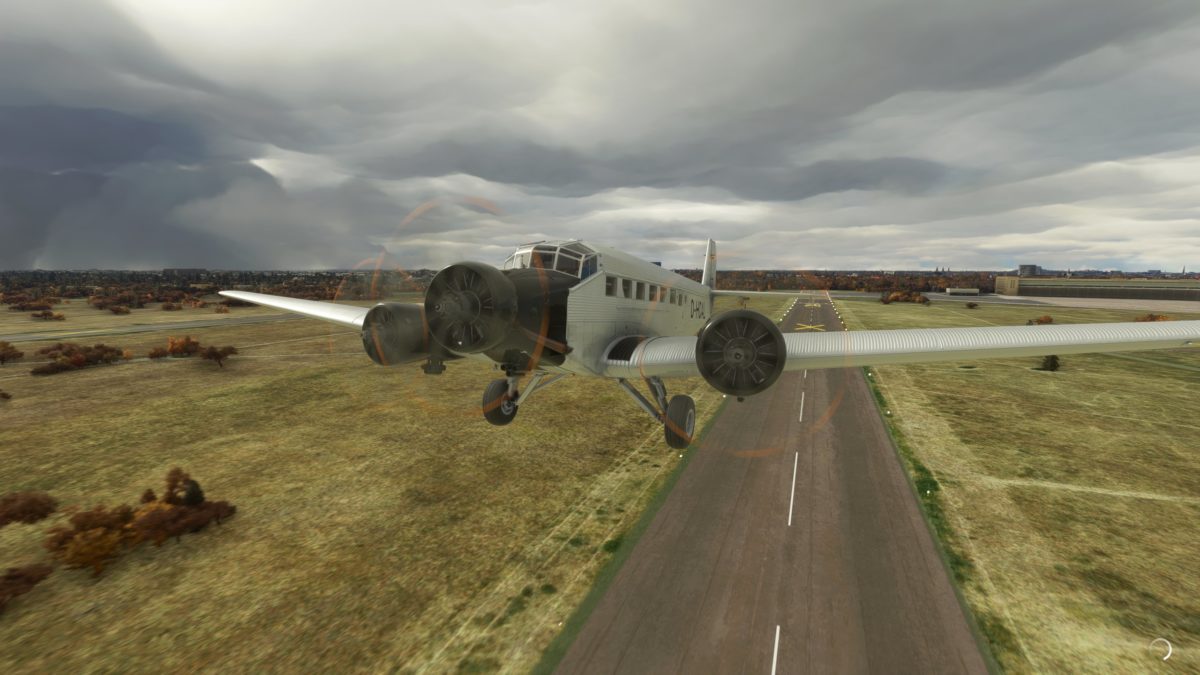
Because of the trimotor configuration, there is very little torque at all, and it pretty much takes off in a straight line with little need for rudder input – a nice contrast to single-motor fighters of the same era.
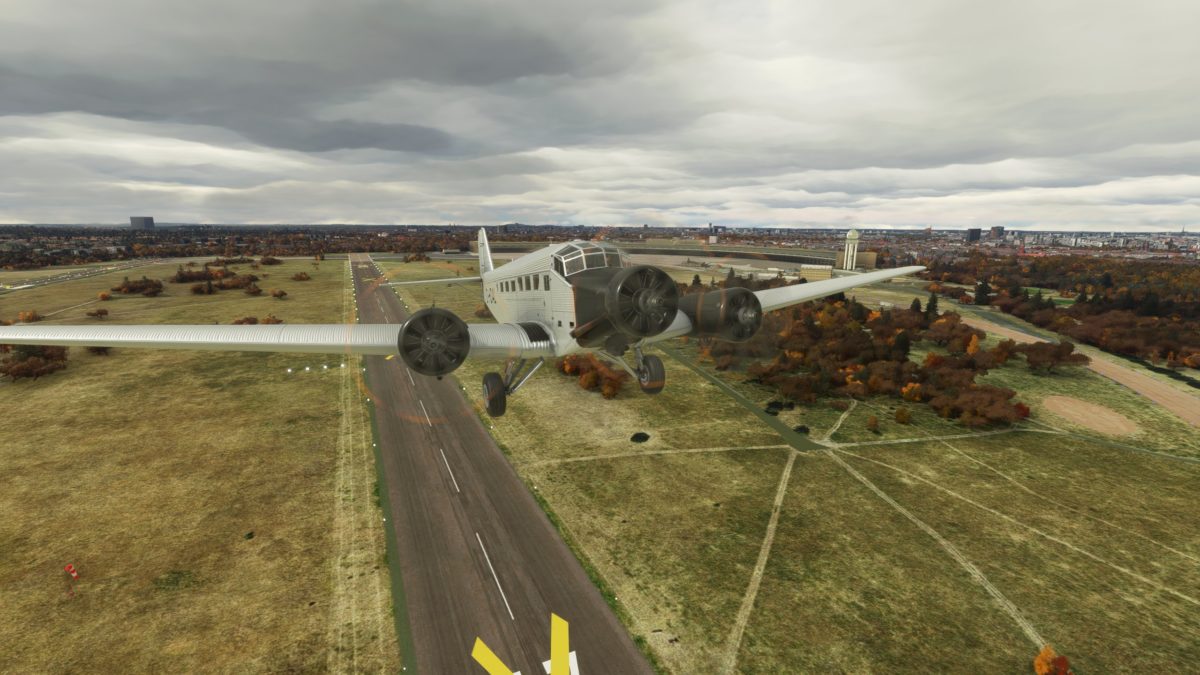
I was flying real weather, and it was a foggy morning in Berlin.
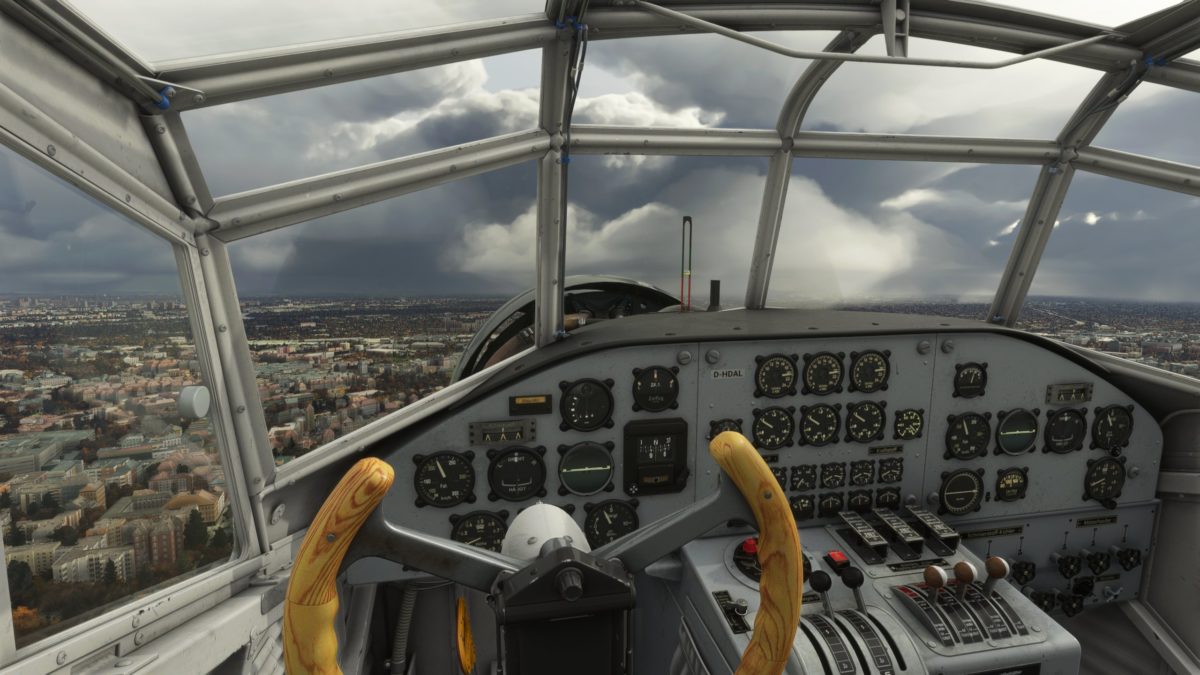
Tempelhof is just south of Berlin’s main city center.
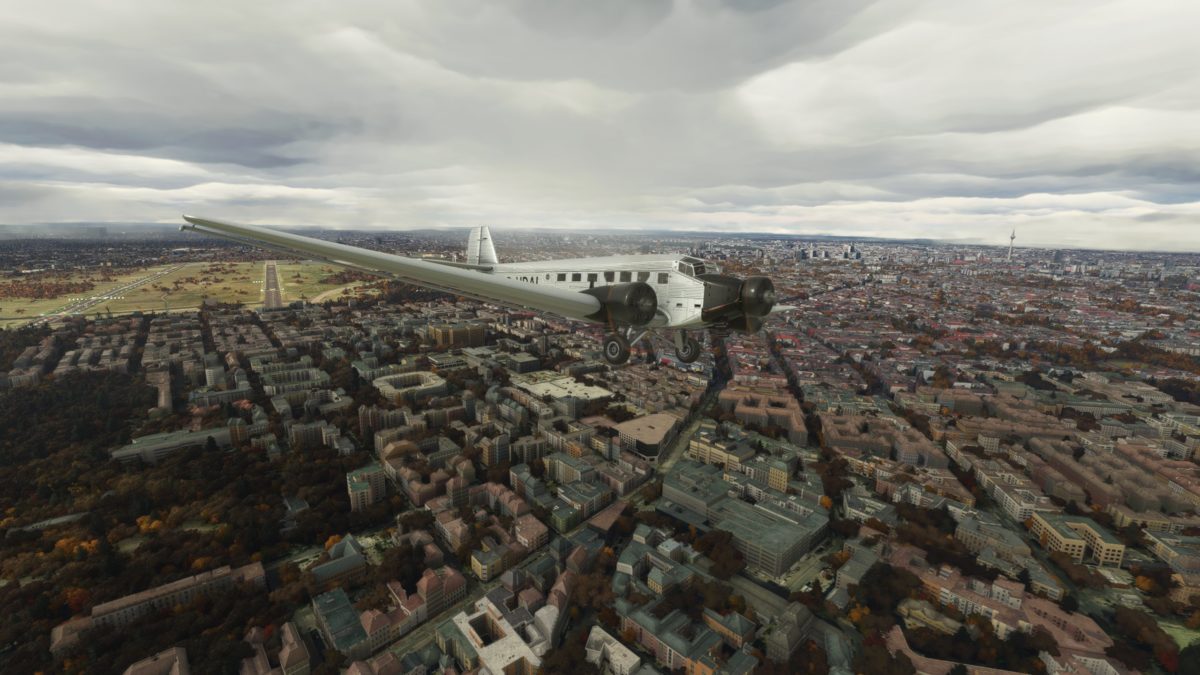
Flying over Alexanderplatz below, with its TV tower. After the war, this plaza, near the city hall, became the center of Soviet-occupied East Berlin.
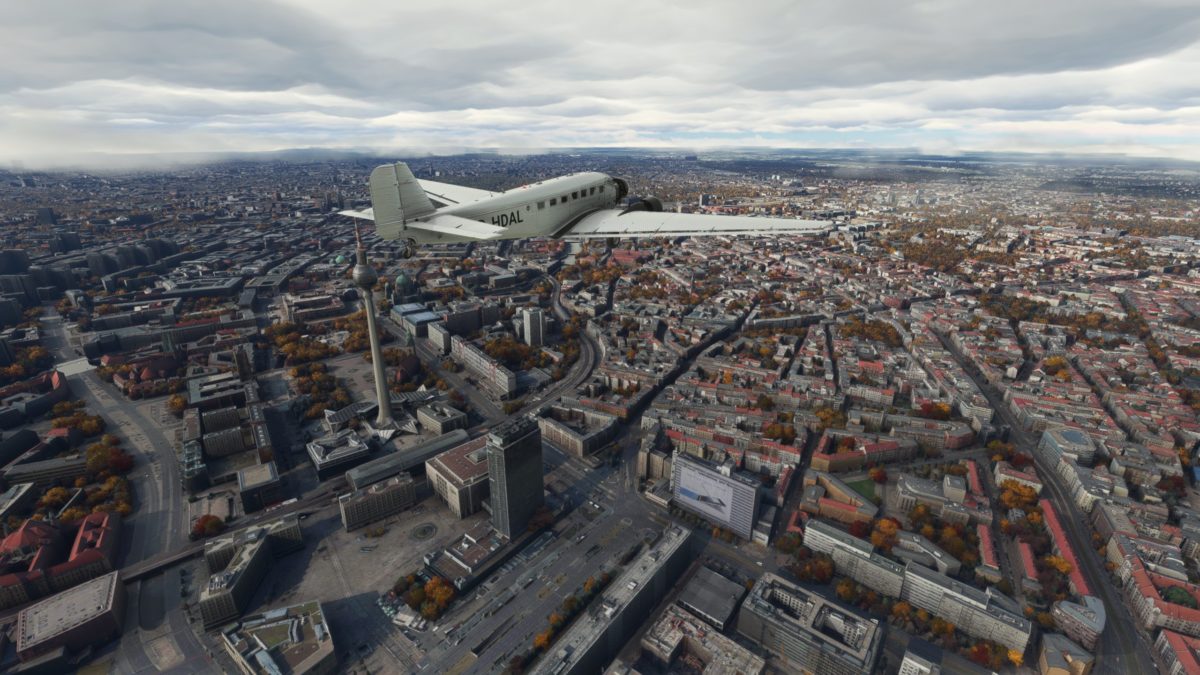
To the right, beyond Alexanderplatz, you can see Berlin’s green-domed cathedral. On my last trip to Berlin, I stayed in the blue-roofed hotel right next to it.
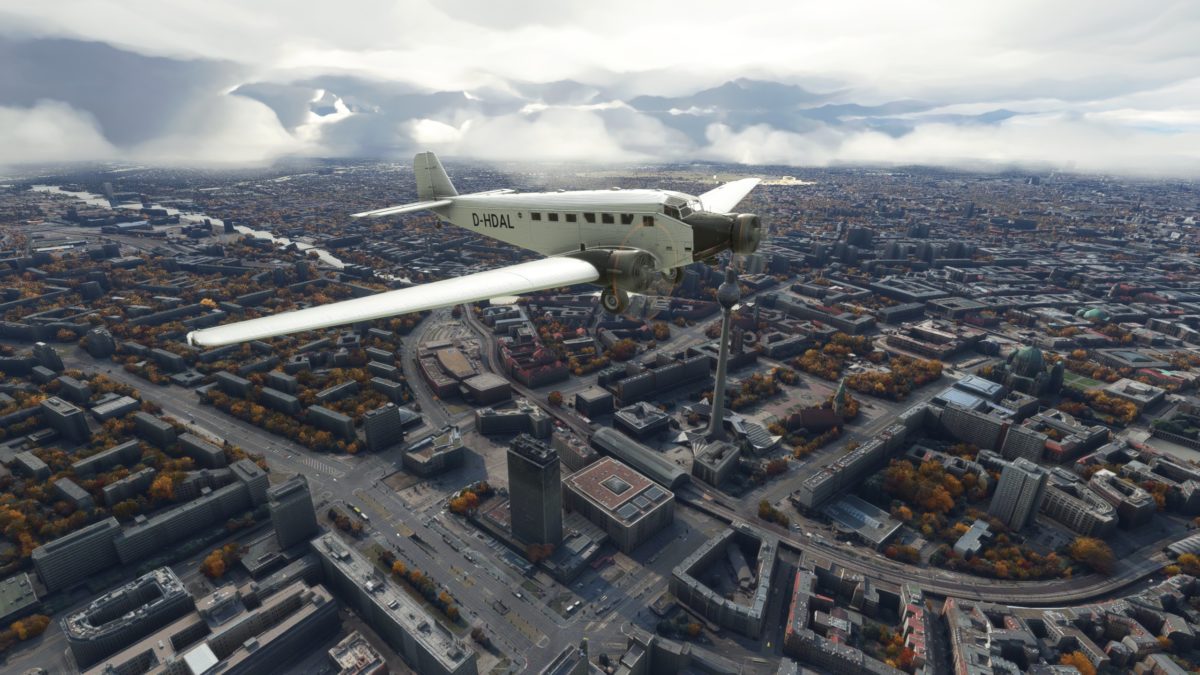
That’s Museum Island, just off the tip of my left wing next to the cathedral, and the center of old Berlin, with Tempelhof Airport in the distance, looking south.
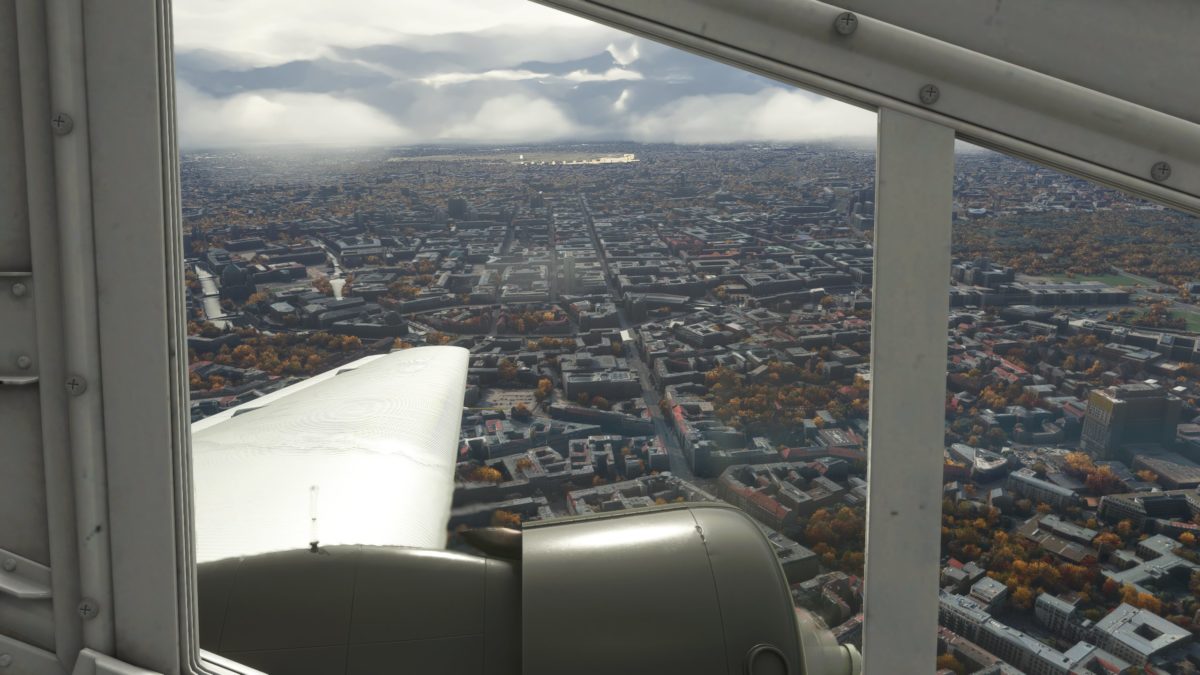
Flying over the Tiergarten, with central Berlin behind me, to the east. Note the fall colors (I have a seasons mod on).
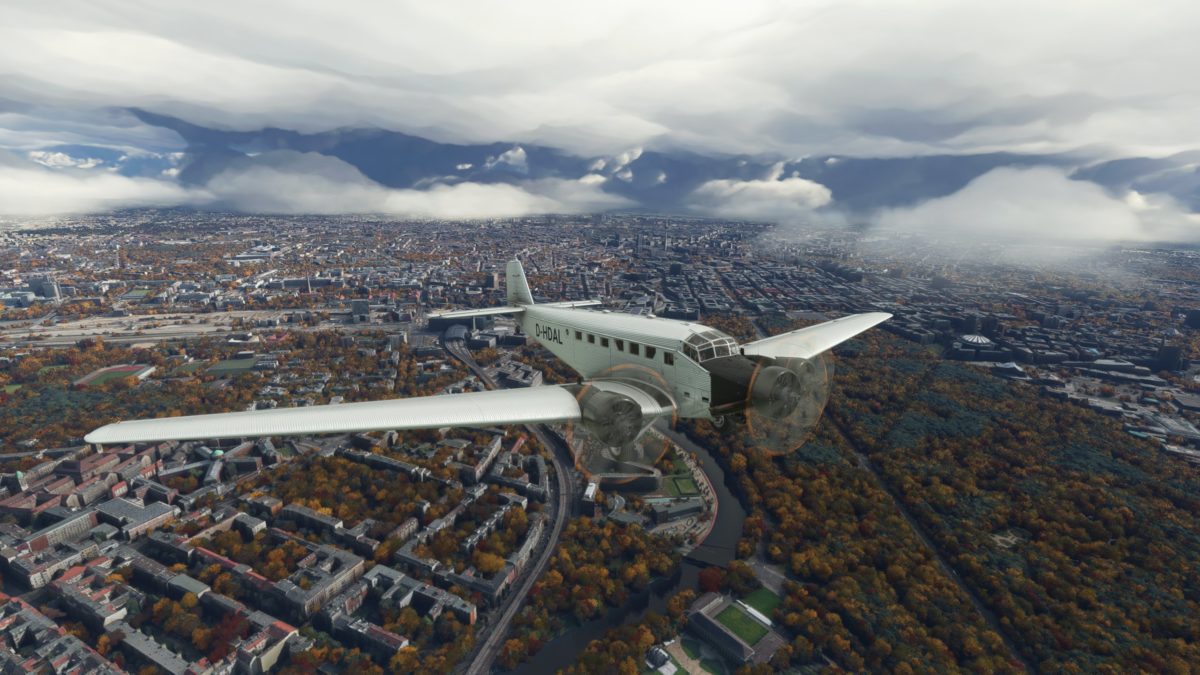
Turning right towards the Charlottenburg Palace, ahead. We’re now in what was once Allied-occupied West Berlin.
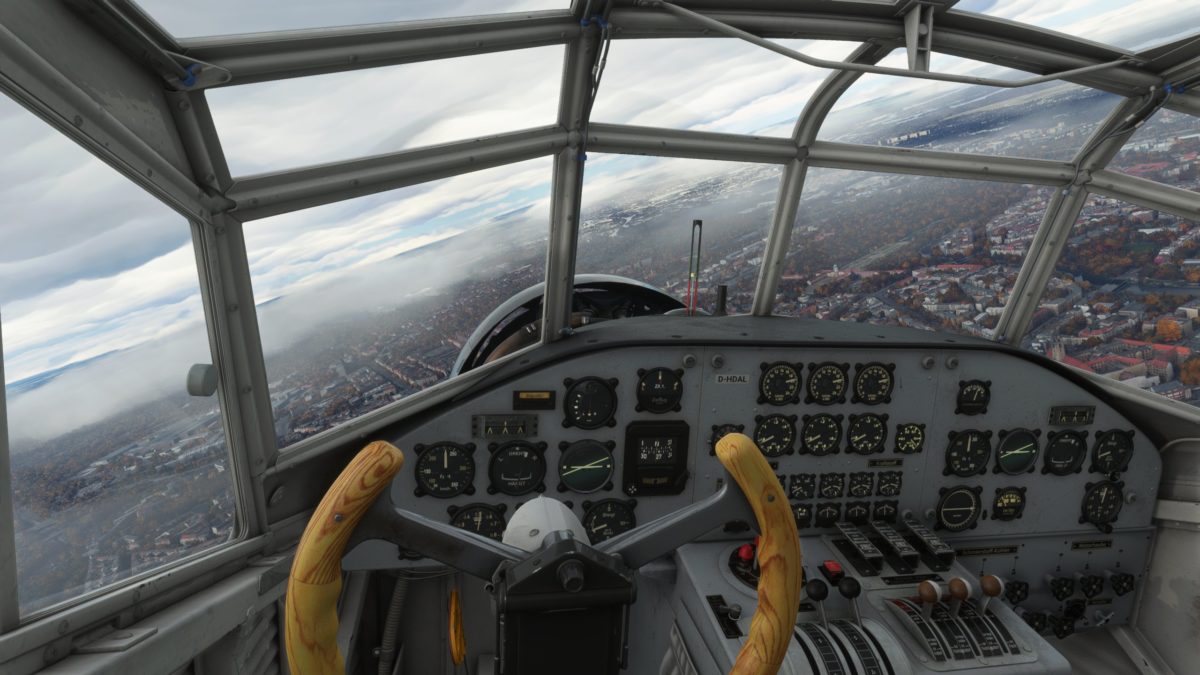
The Ju 52 flies at a cruising speed of roughly 250 km per hour, which is roughly 135 knots (the airspeed indicator is in kilometers, and the altimeter is in meters).
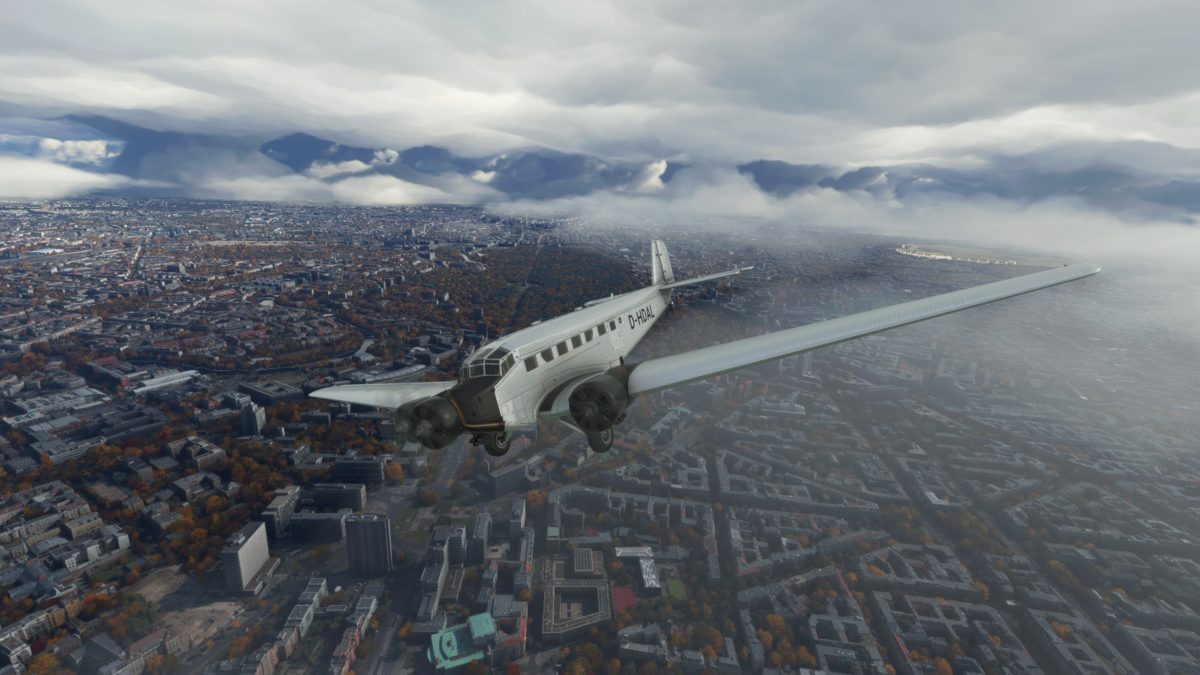
The Charlottenburg Palace, under my left wing. Tegel Airport, which was until recently the city’s main airport (before closing in 2020) is straight ahead, to the north.
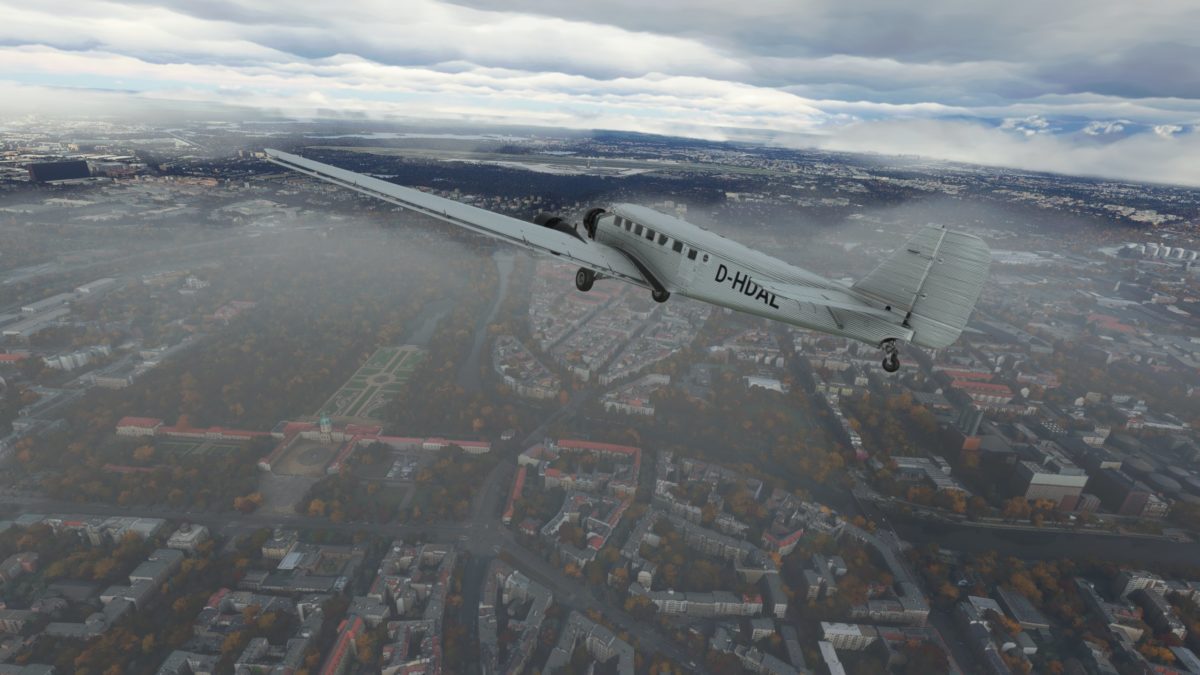
Turning to the southwest. At 250 km/h, the Berlin to Rome route across the Alps took 10 hours – incredibly short by the standards of the day.
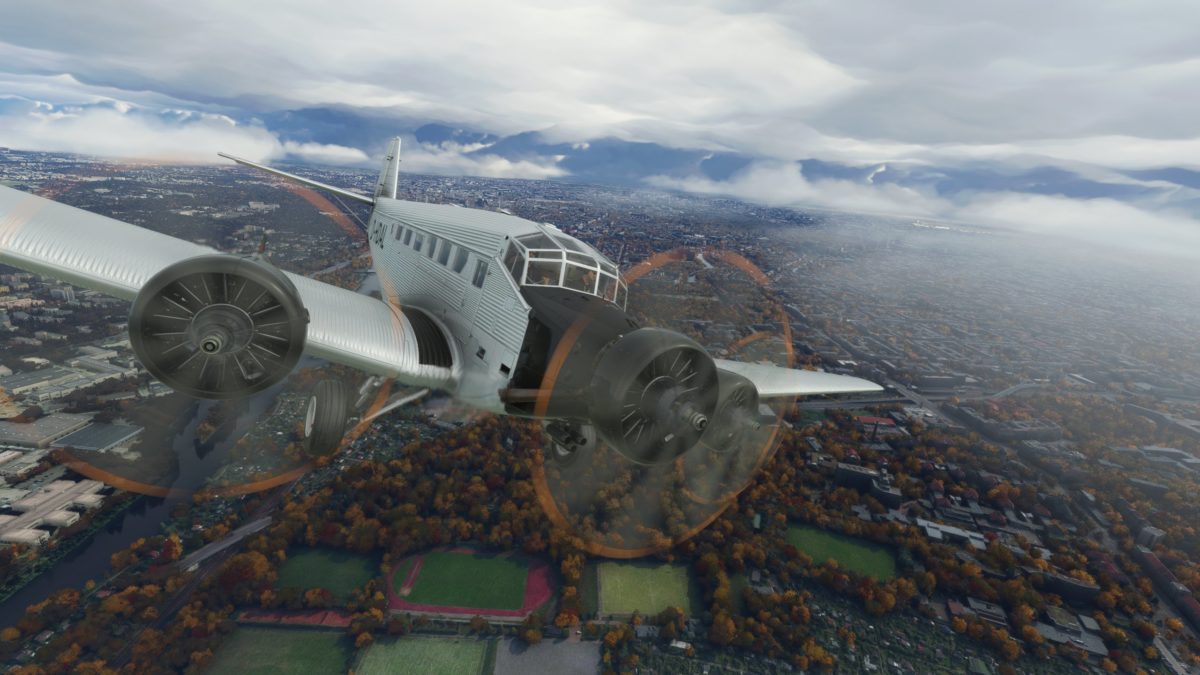
Although the Ju 52 could climb to 19,000 feet, above at least some of the weather en route, the cabin was not pressurized. Passengers were provided with oxygen if and when needed.
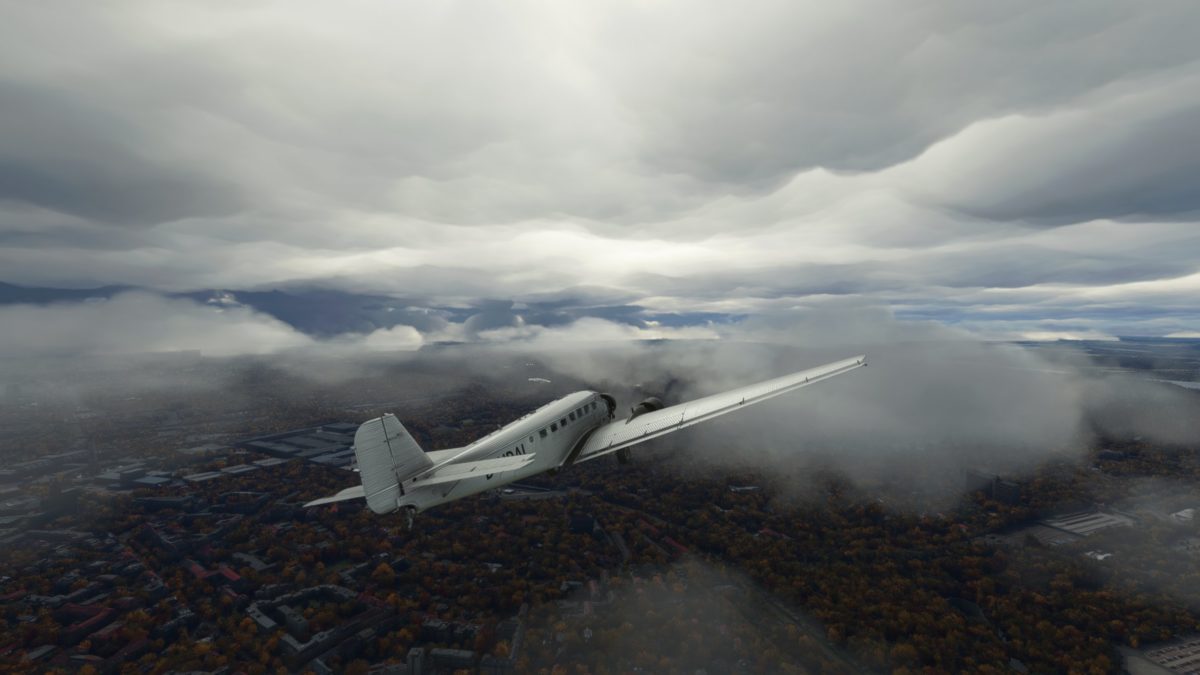
Passengers also had access to a foldable typewriter (a laptop!) and could send telegrams en route by Morse code via the cockpit.
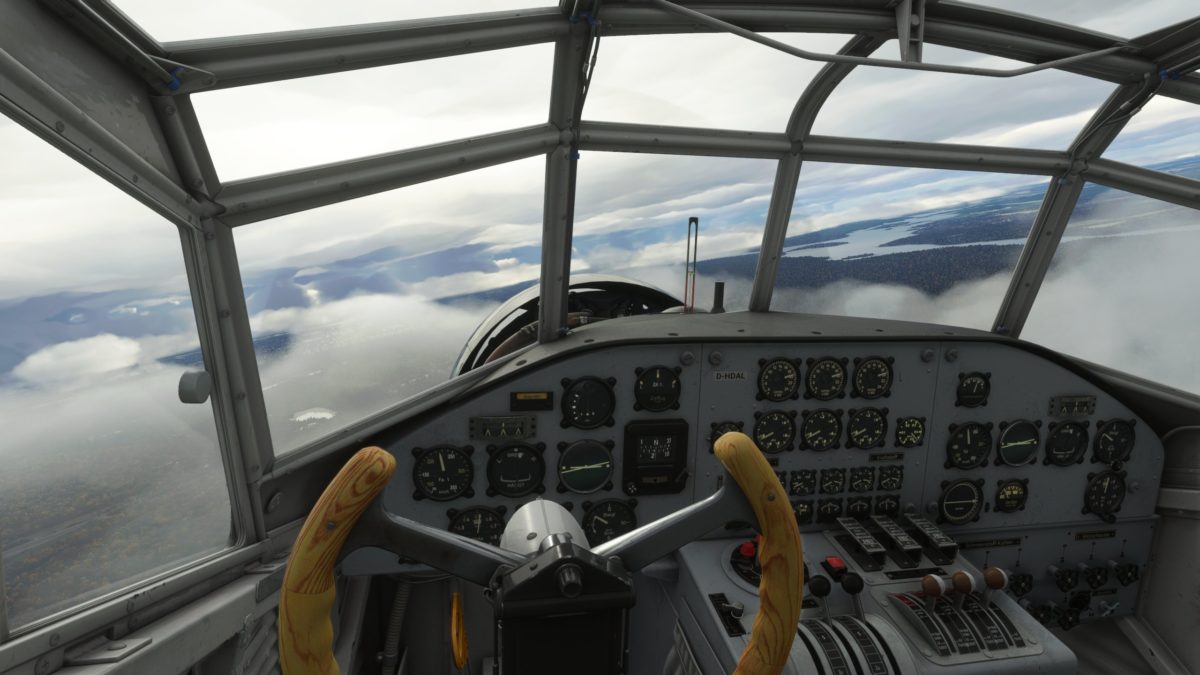
Ju 52s were sold to airlines around the world: Italy, Switzerland, Canada, South America, China. But the main customer, of course, was Luft Hansa, Germany’s national airline established in 1926.
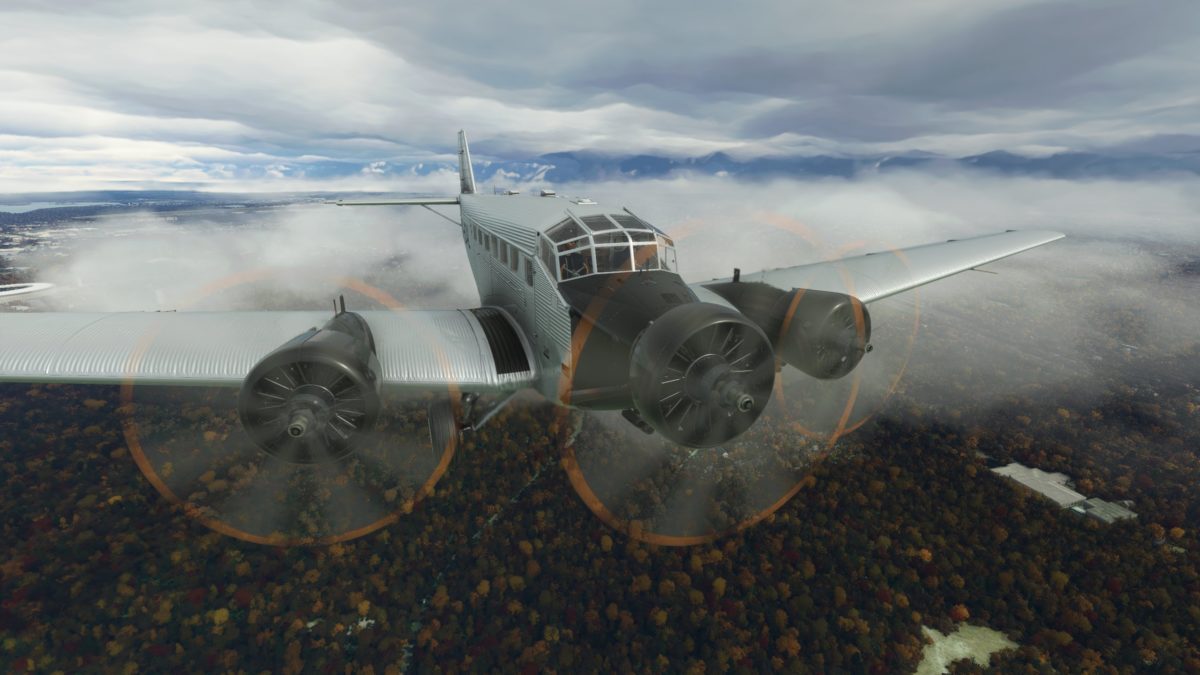
Of course Hitler was well known for using air travel, including a swastika-embossed Ju 52, as transport to political rallies across the country.
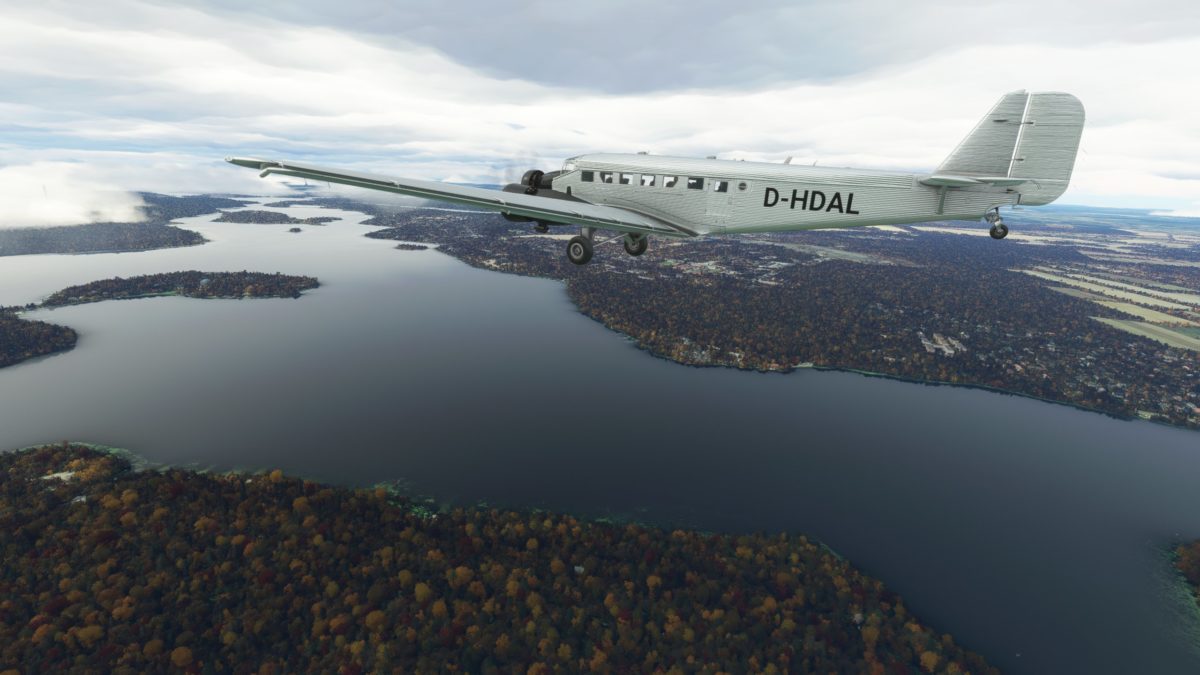
Hitler’s Ju 52 approaching Nuremburg comprises the famous opening scene of the Nazi propaganda film “Triumph of the Will”:
Junkers aircraft, including the Ju 52 and the Stuka divebomber, are closely linked in the popular imagination with the Nazis. In fact, Hugo Junkers openly opposed the Nazis, and initially refused to participate in Hitler’s rearmament program.
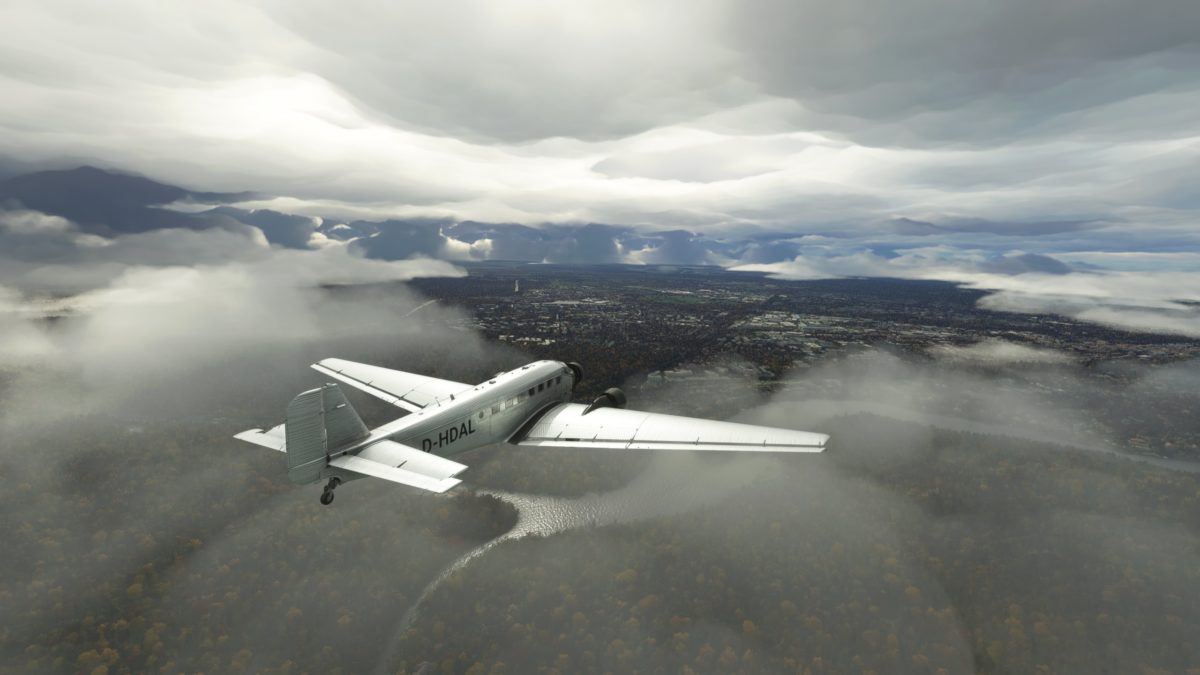
Flying over Germany’s historic film studio at Babelsberg, just under my left wing, outside of Potsdam, southwest of Berlin.
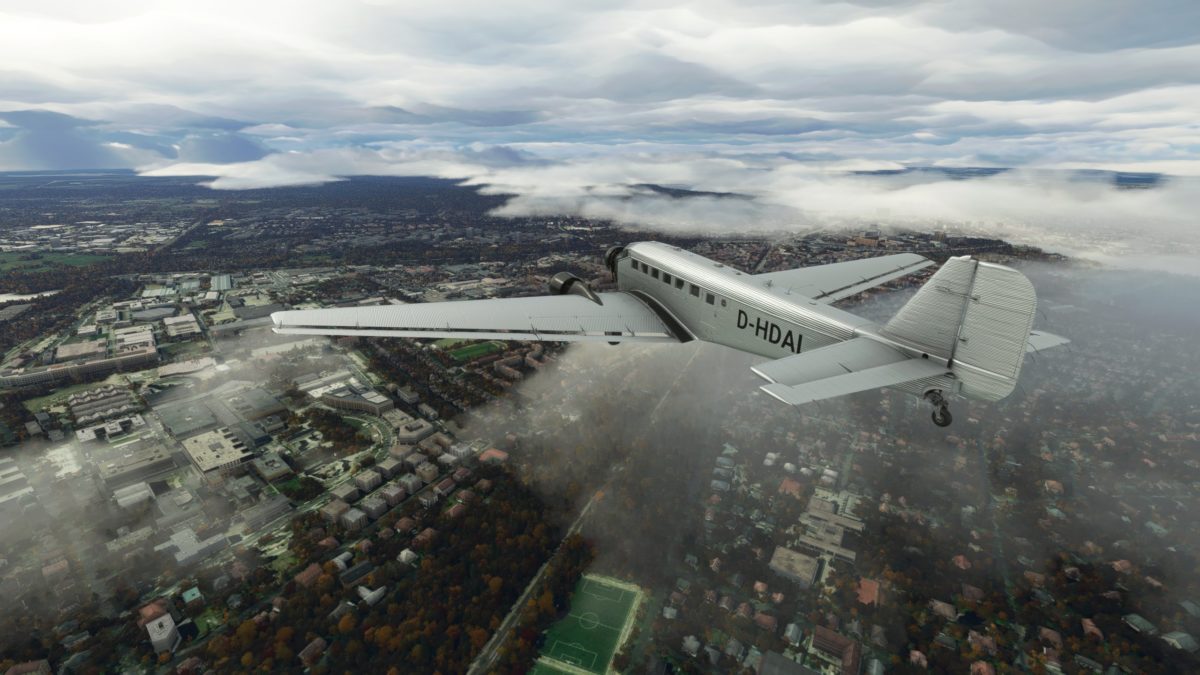
Frederick the Great’s palace at Potsdam, below.
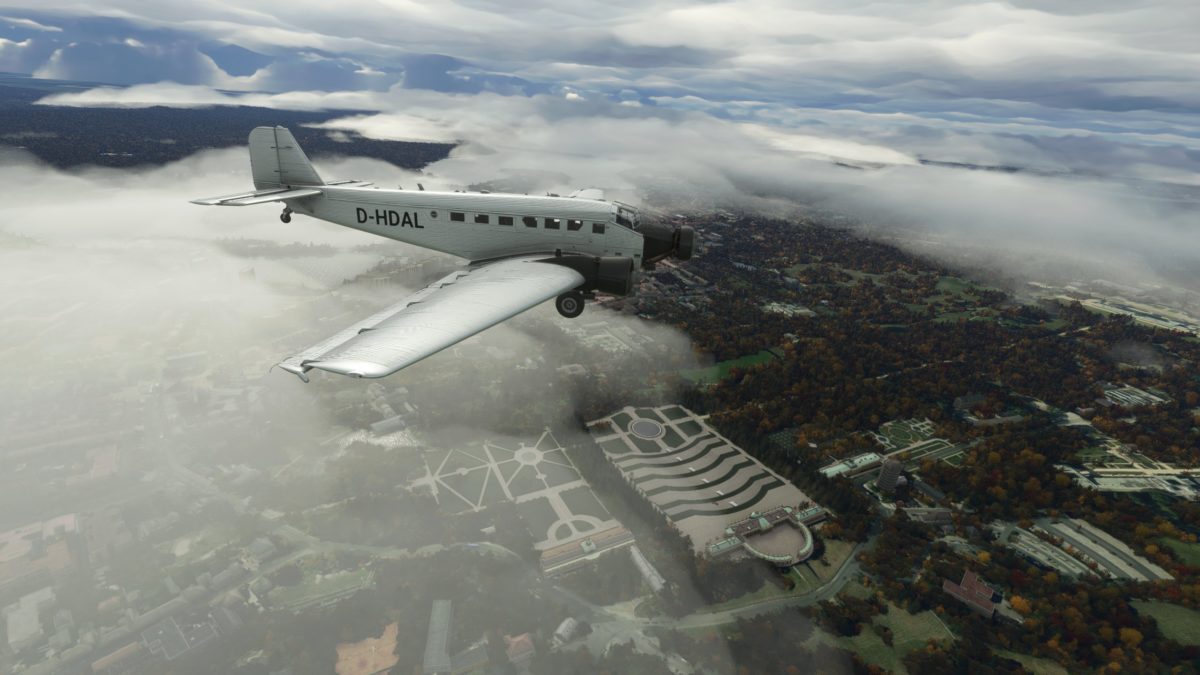
After defying the Nazis, Hugo Junkers was forced out of his company, and it was taken over by the German government in 1935. He could easily have found himself sent to a concentration camp, but he died while the expropriation was still underway.
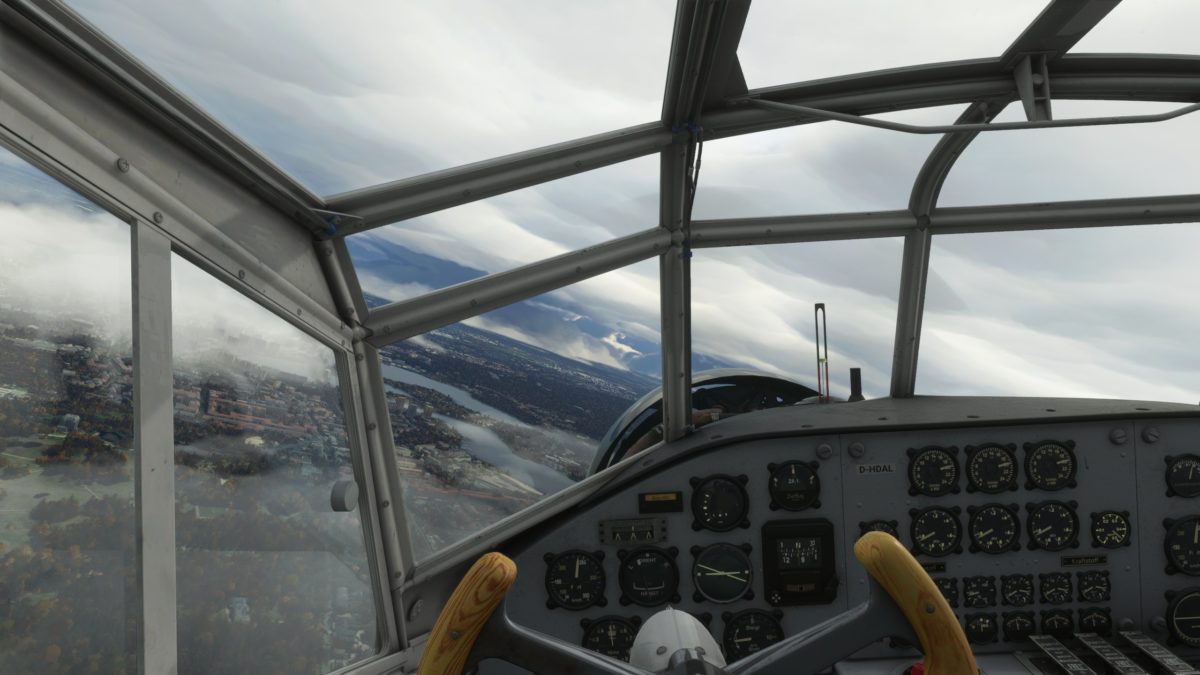
Under government control, the Junkers company became a vital component of the Nazi war machine. It’s a sad irony that Junkers’ name is invariably associated with it. (Another view of Sanssouci at Potsdam, below).
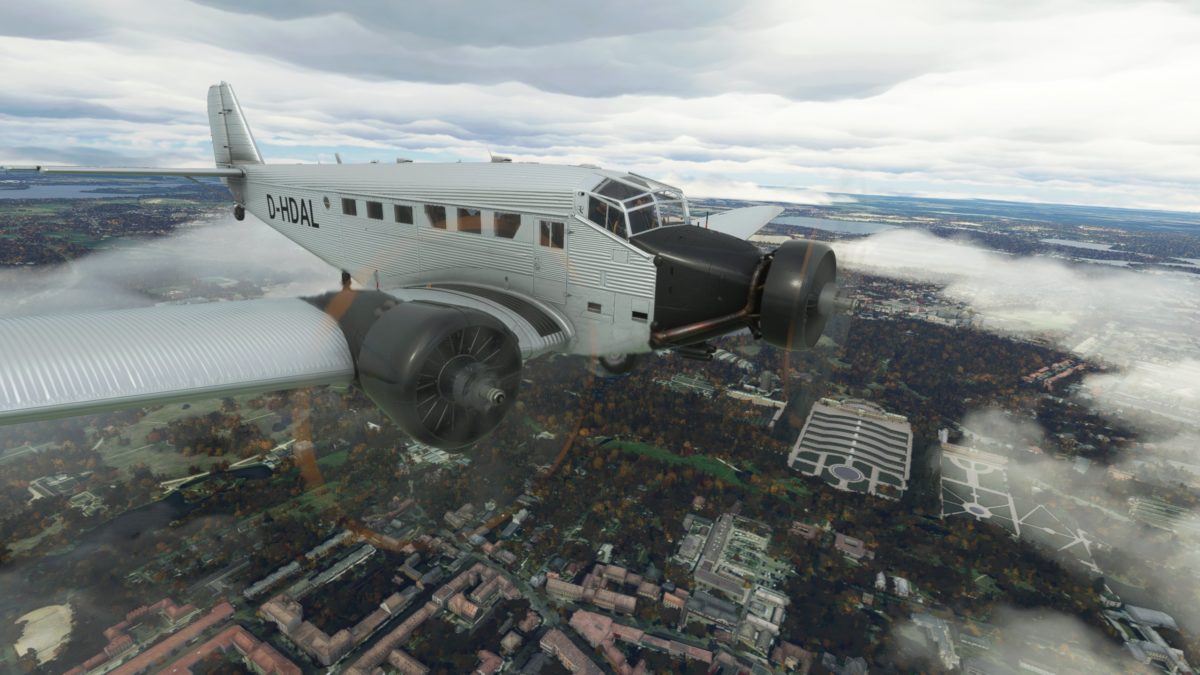
Luft Hansa’s airliners were used to secretly train pilots for the Luftwaffe. And a military version of the Ju 52 was developed to serve as a troop transport, and – for a time – a bomber. (That’s the town of Wannsee below me, where the conference to plan the Holocaust took place).
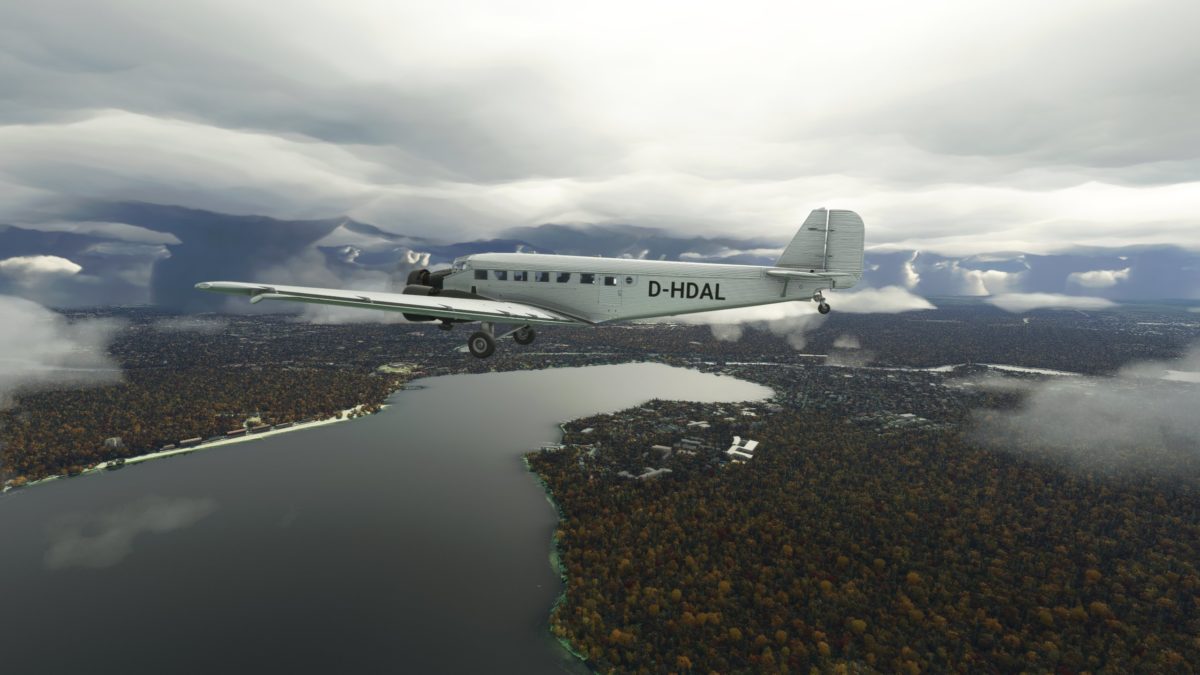
During the Spanish Civil War, German Ju 52s were used as bombers, before new fighter aircraft made them obsolete. The planes that bombed the town of Guernica were Ju 52s.
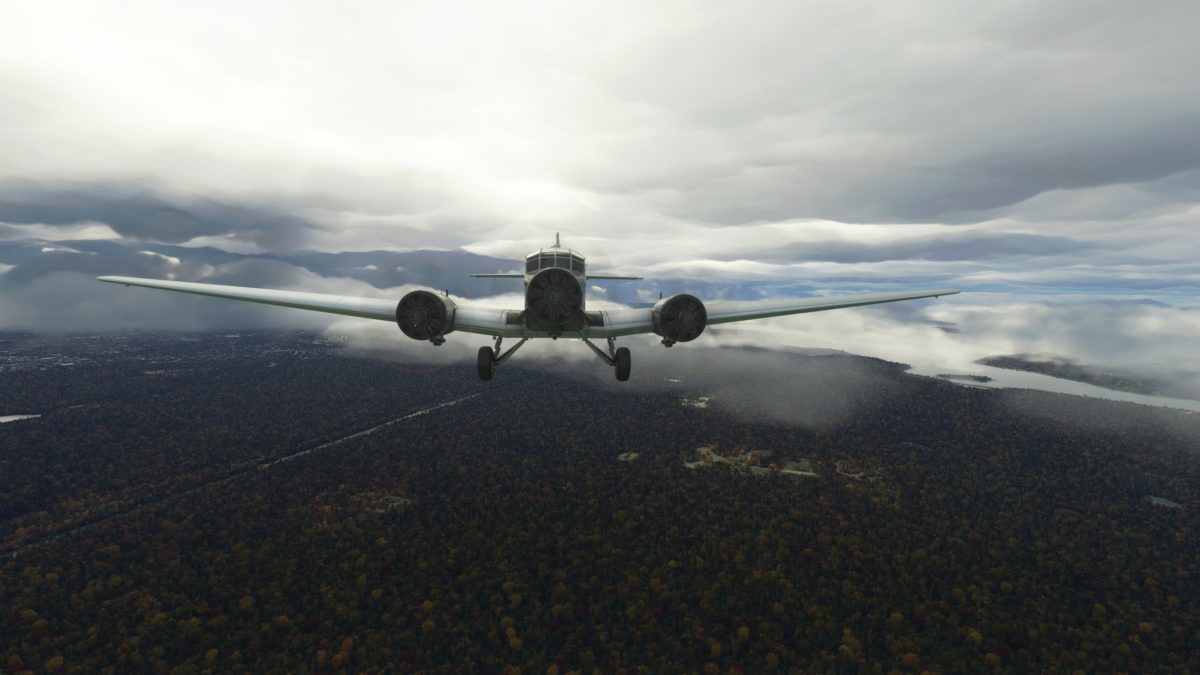
Flying over the stadium that was built for the 1936 Olympics, just west of Berlin.
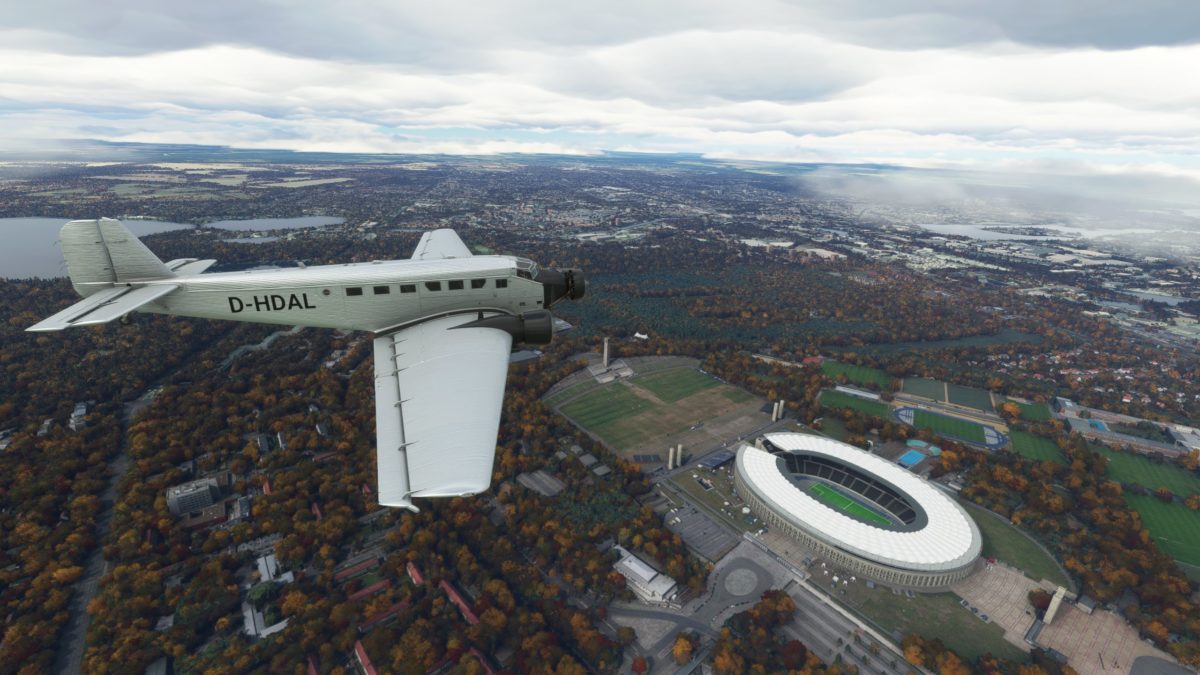
During World War II, the Ju 52 was used (successfully) to drop German paratroops over Crete, and (unsuccessfully) to bring supplies to the German armies surrounded at Stalingrad.
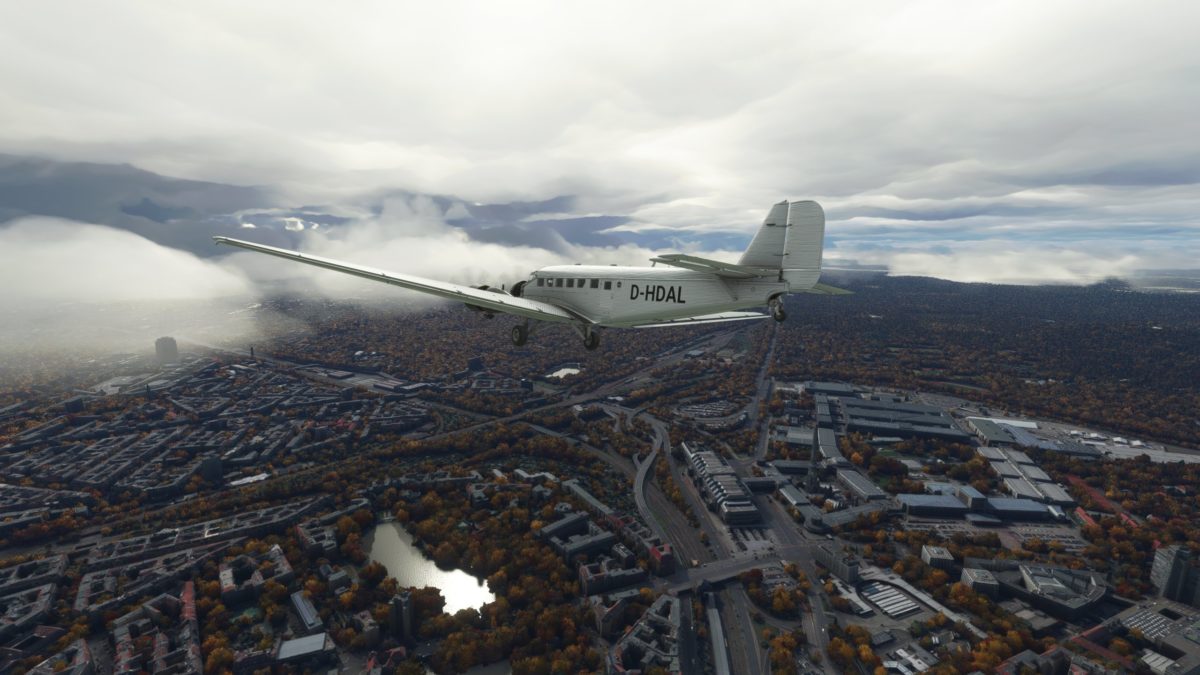
The western half of Berlin, outside my left window.
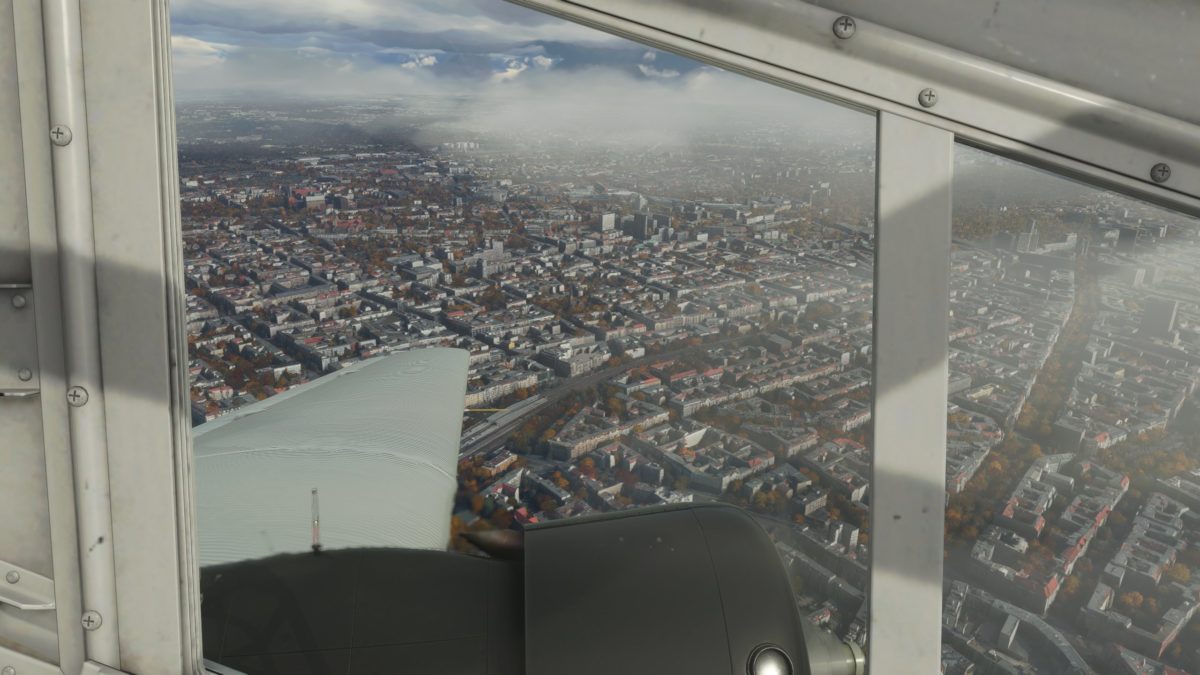
Kurfürstendamm, below, on of the main streets in the western part of Berlin.
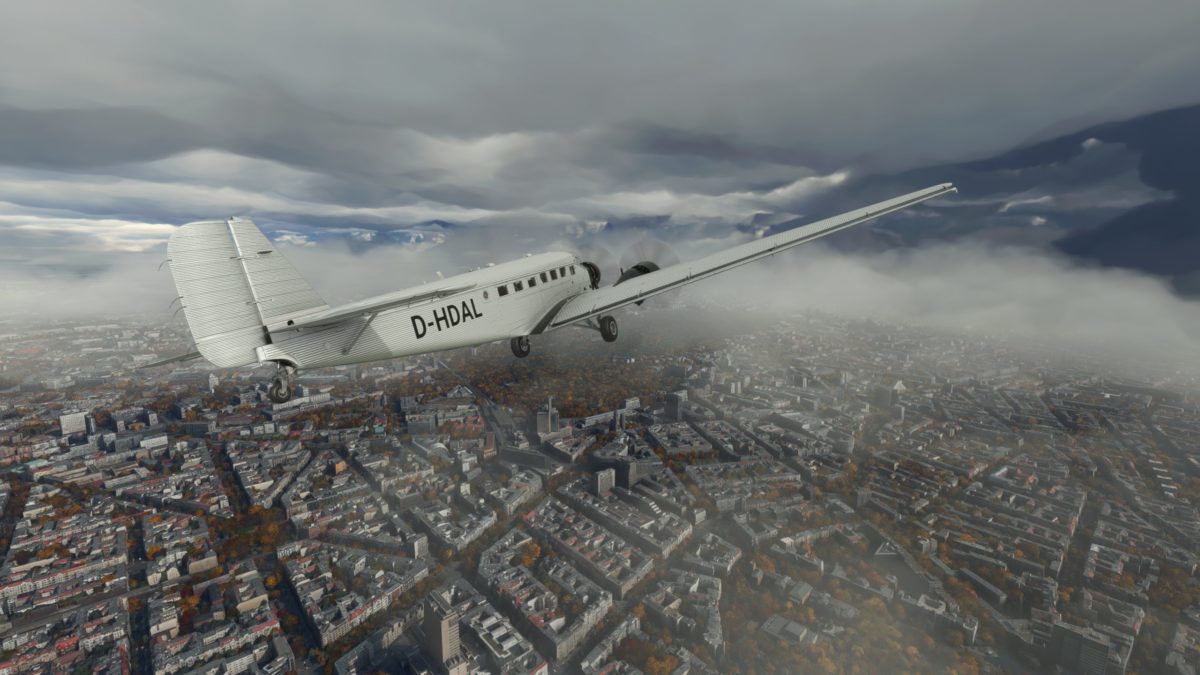
Approaching the Tiergarten again, from the southwest, with the Victory Column at its center.
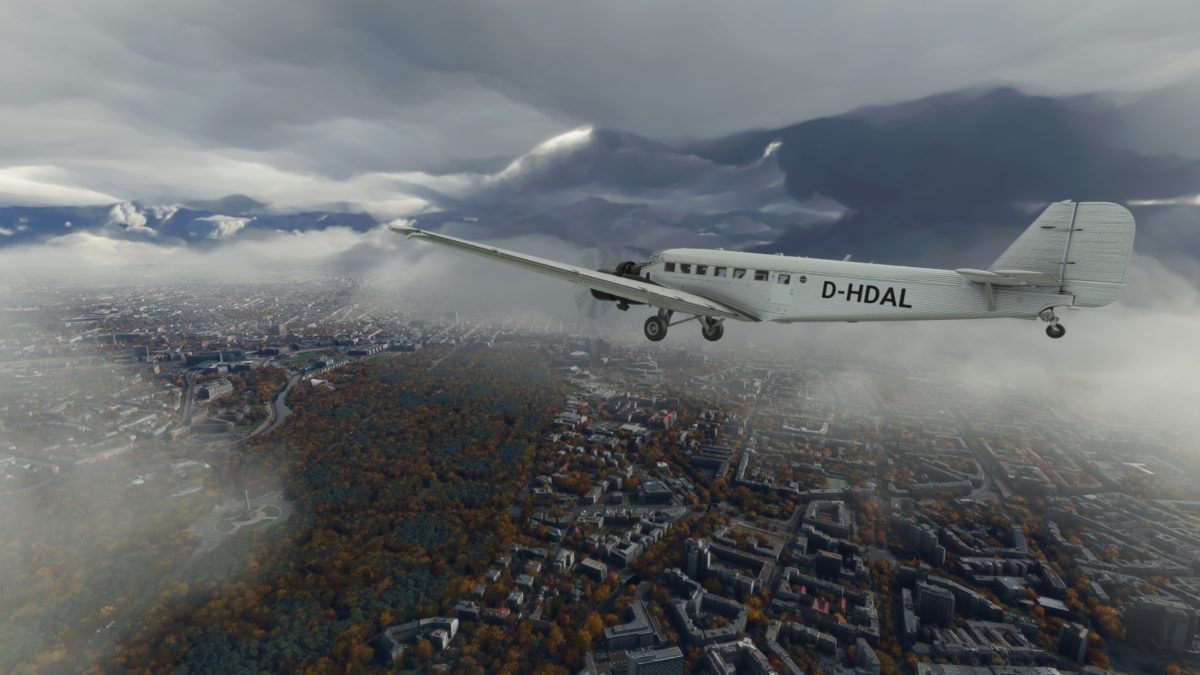
That’s the Reichstag and the Brandenburg Gate below me, barely visible in the mist. The fog is really coming in, and I certainly can’t see Tempelhof to land.
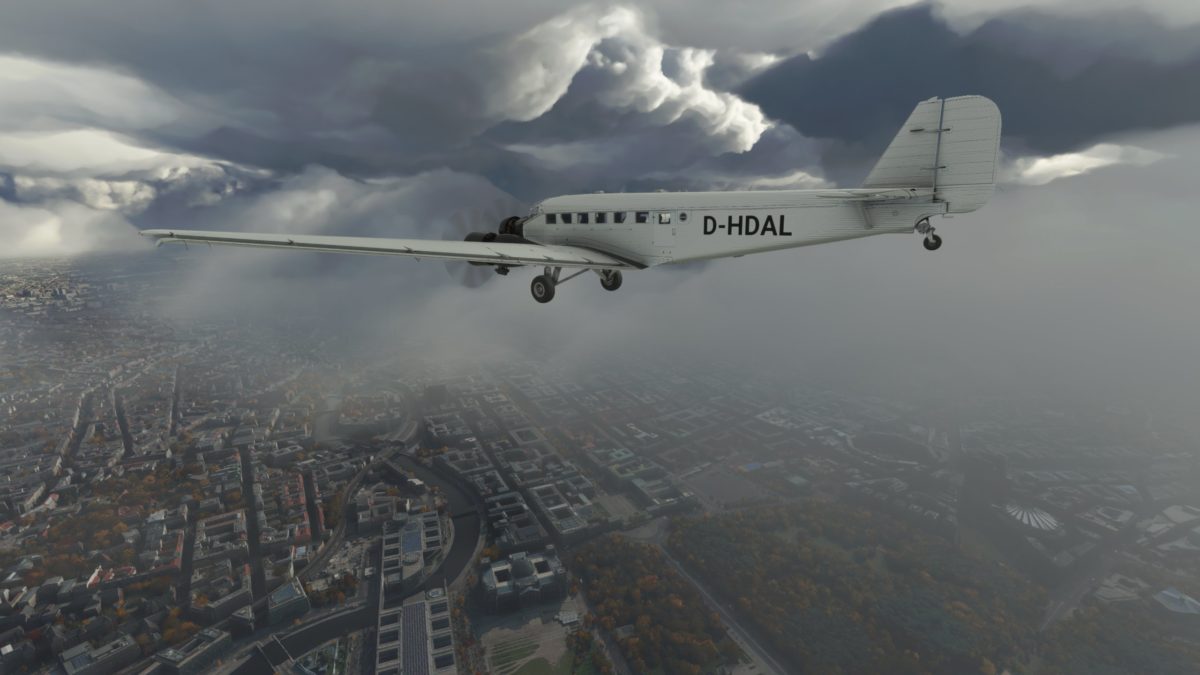
The street that runs from the Tiergarten through the Brandenburg Gate into the city is called Unter den Linden, Berlin’s historic main boulevard.
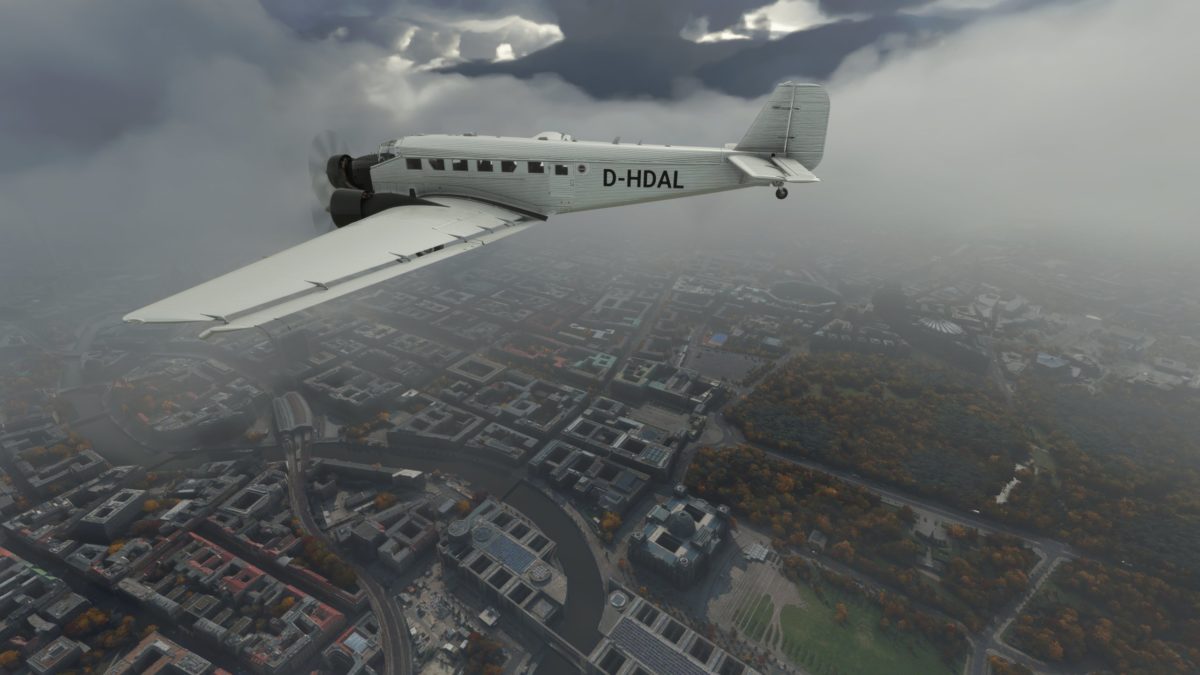
I’ve dodged the clouds, and that’s Tempelhof gleaming in the distance.
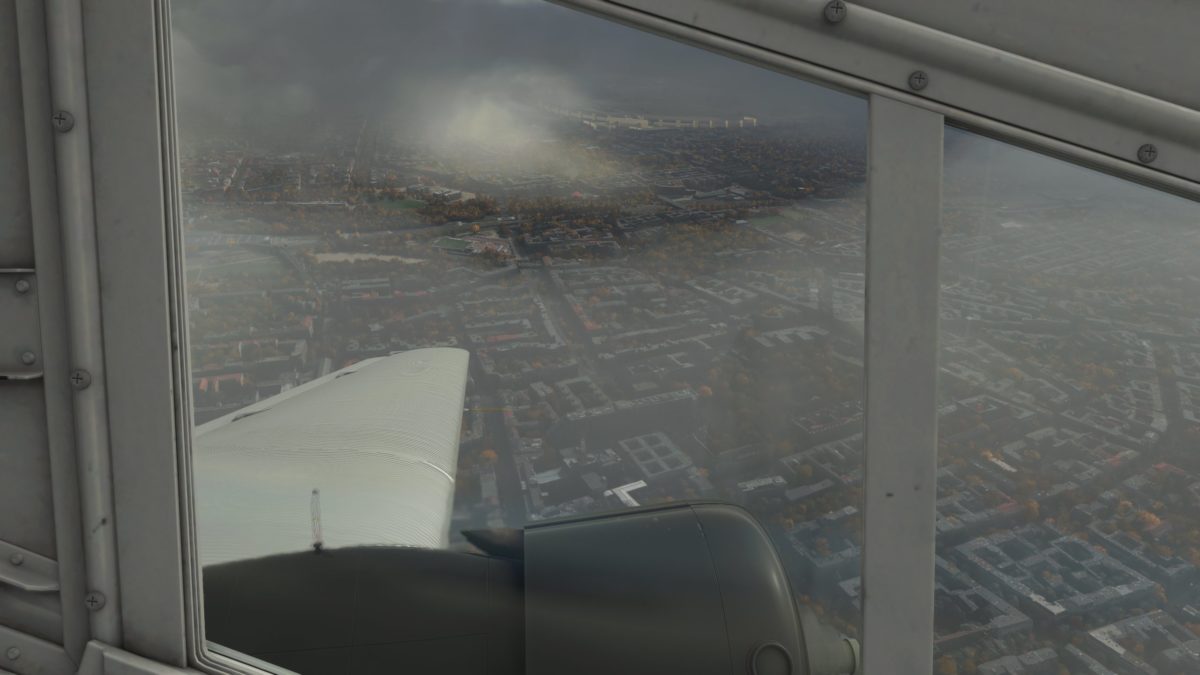
But as I enter the pattern to land, visibility goes to zero. Even on the sim, it’s a panicky feeling.
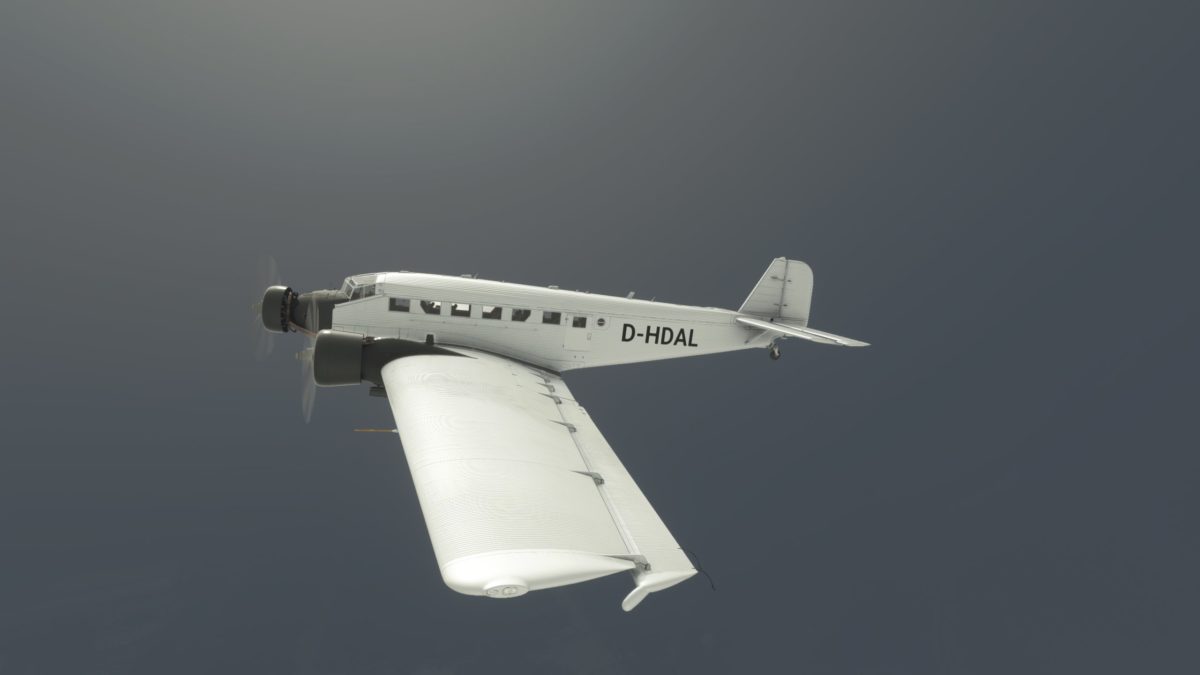
But I focus entirely on my instruments to remain oriented and at a safe altitude as I come around the airport to land.
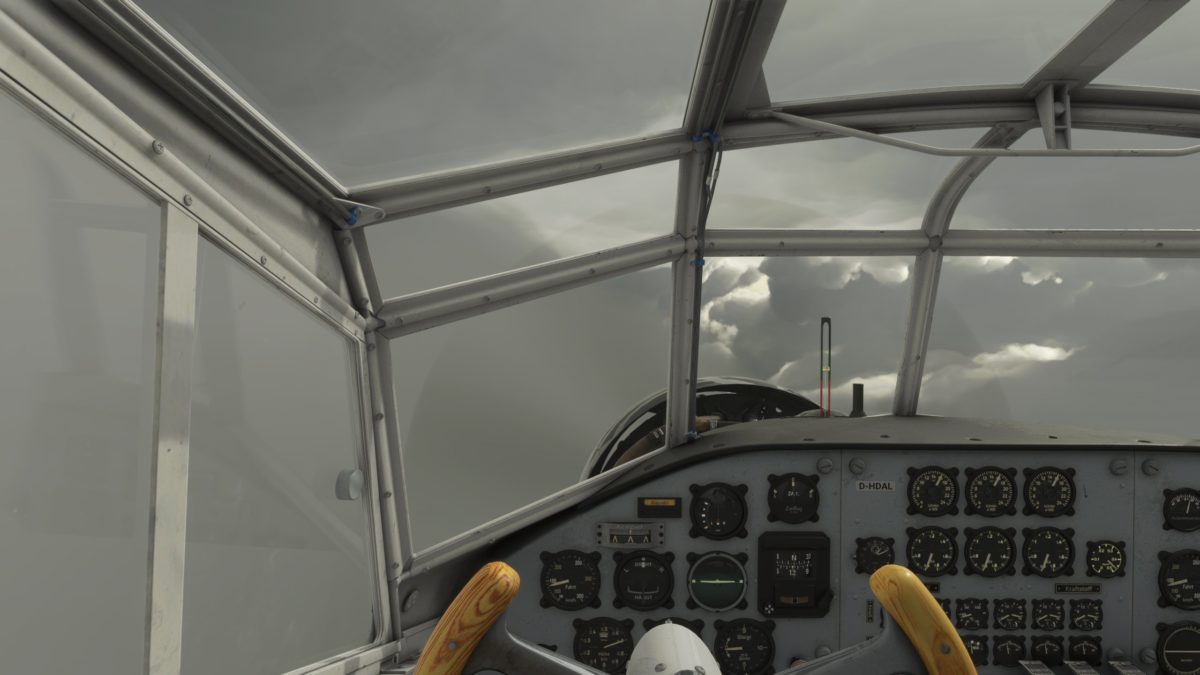
There it is, off my left hand side, as I break free of the fog bank.
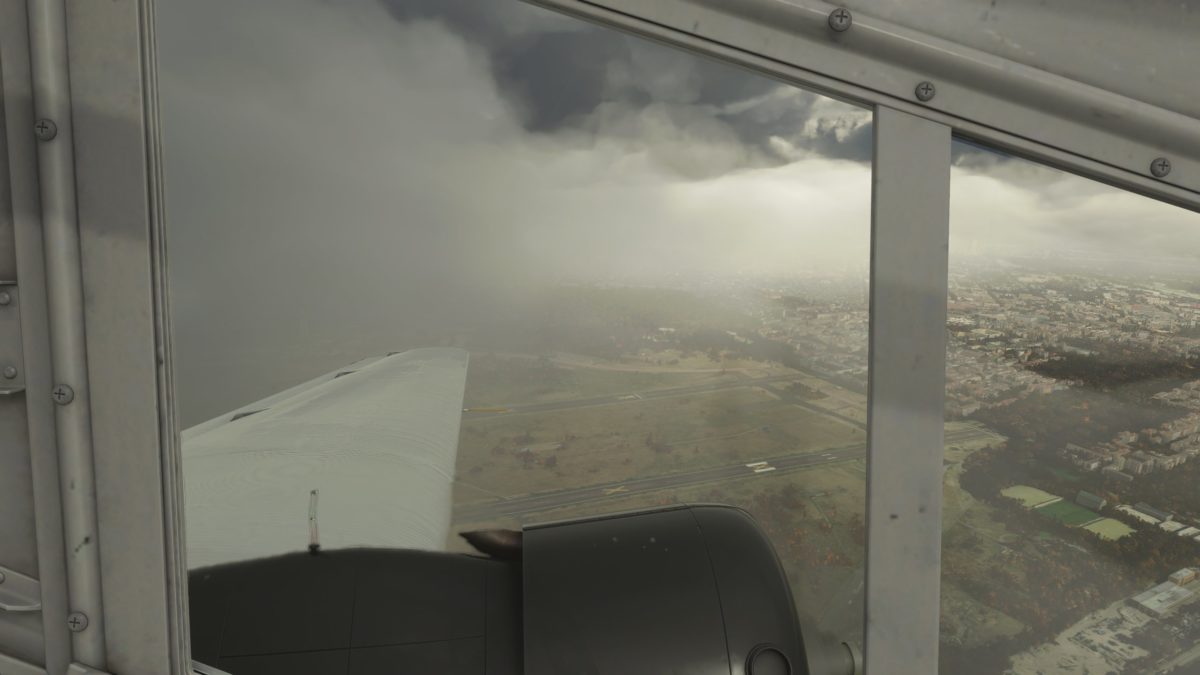
Coming in on final with flaps full down, at about 140 km/h. That’s about 75 knots, only about 10 knots faster than a Cessna 172 on landing.
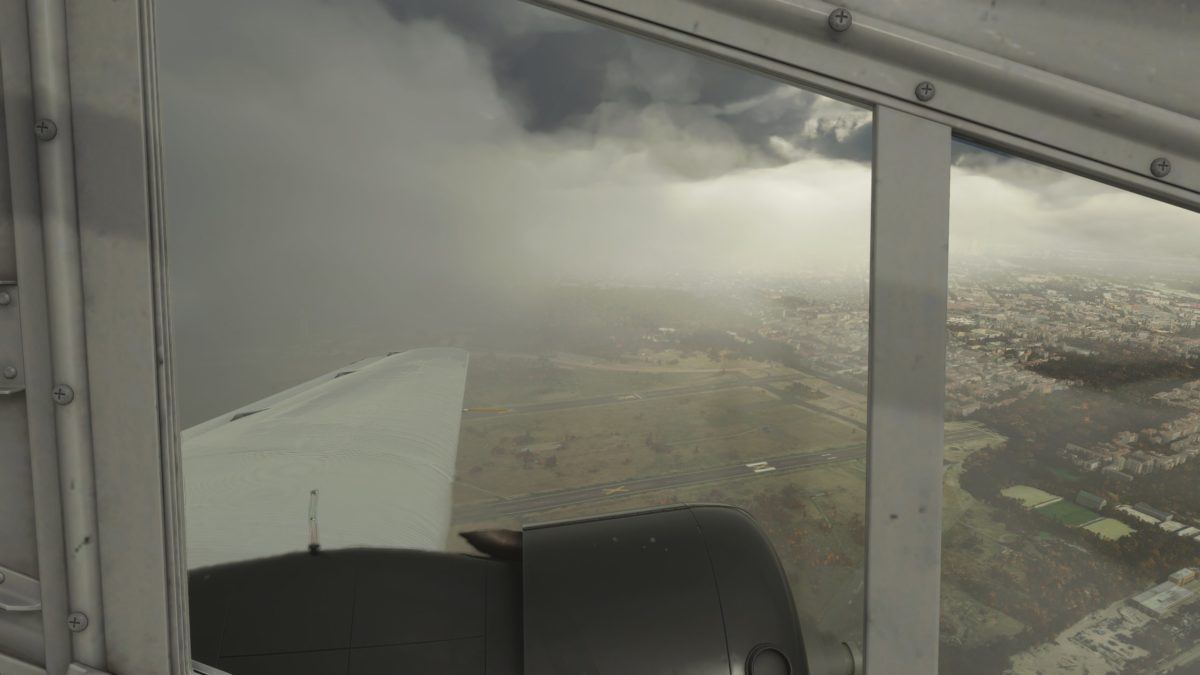
The tricky thing about landing the Ju 52, at least in the sim, is that it’s a very soft touchdown and the tail wants to stay up, so it’s hard to tell when you’re down.
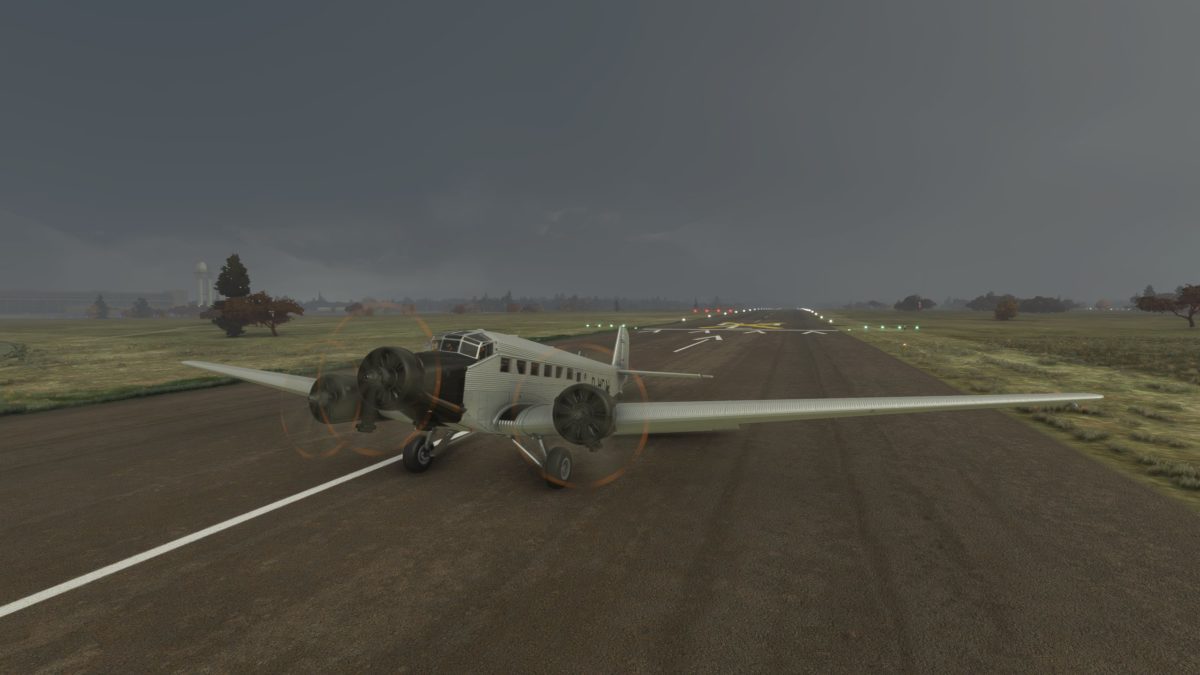
Looks like I made it just before the fog closed in again.
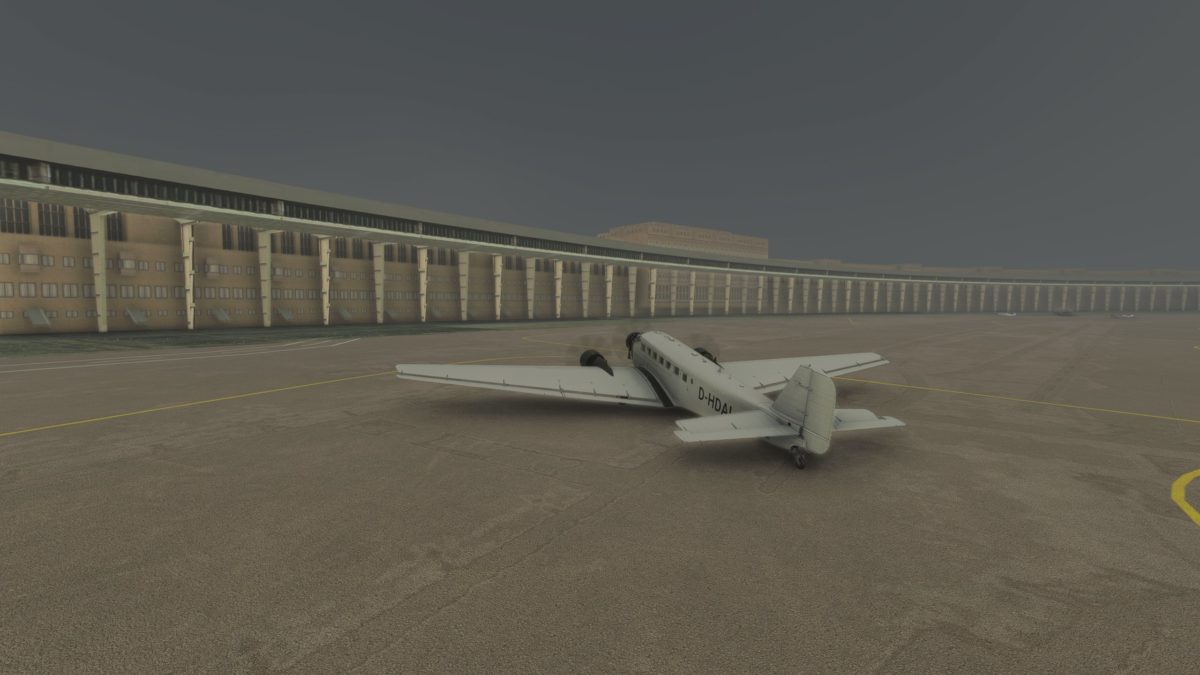
I almost forgot to mention that the military version of the Ju 52 was dubbed “Iron Annie” (as opposed to the civilian “Aunt Ju”).
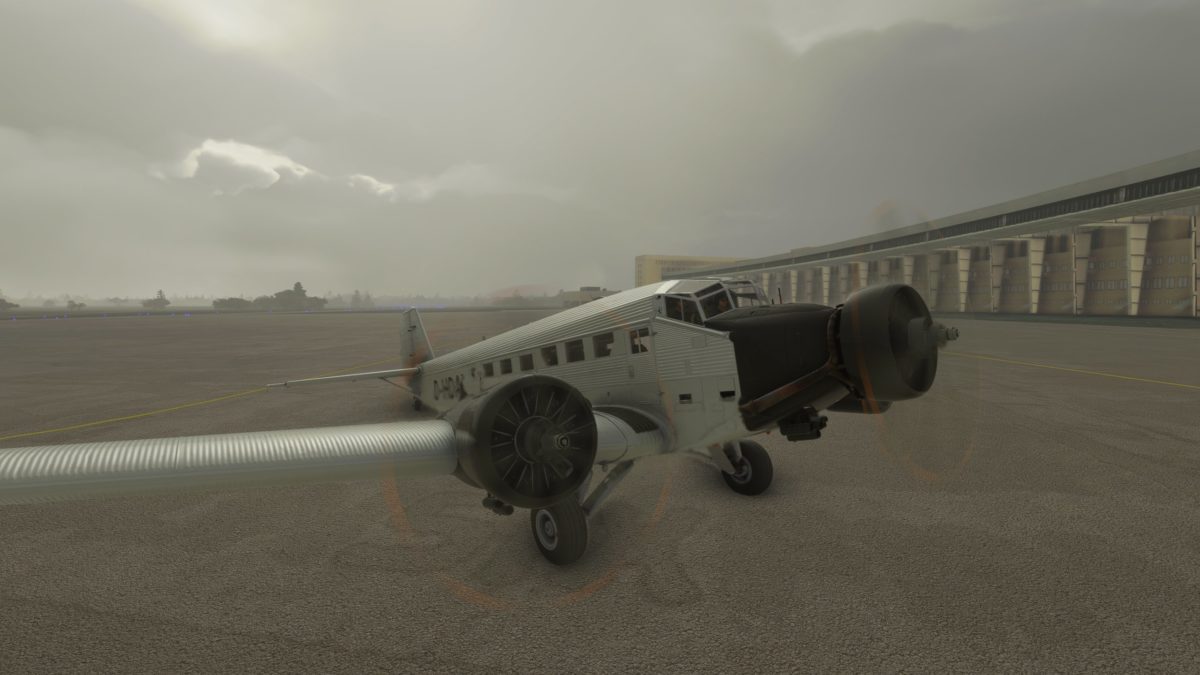
As I explained in my earlier travel thread, Tempelhof was the first airport build with dedicated departure gates. It also had an awning for planes to park under, so passengers could board without getting wet – like today.
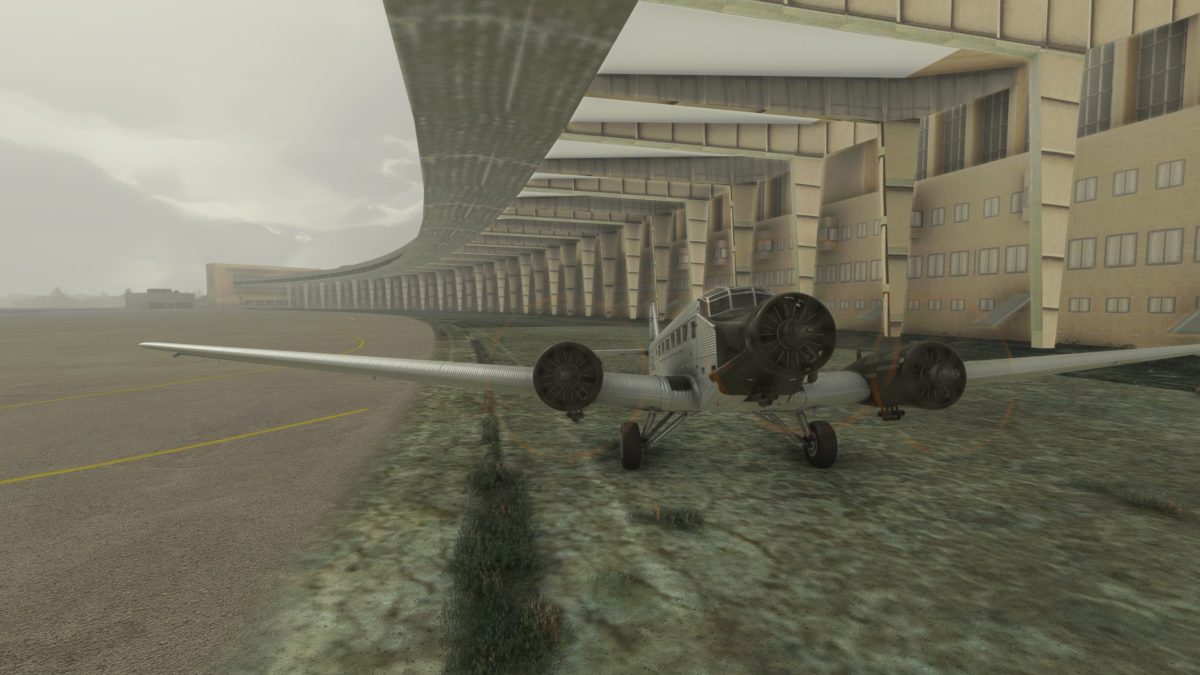
After this foggy landing in Berlin, we need to shift to a warmer clime …
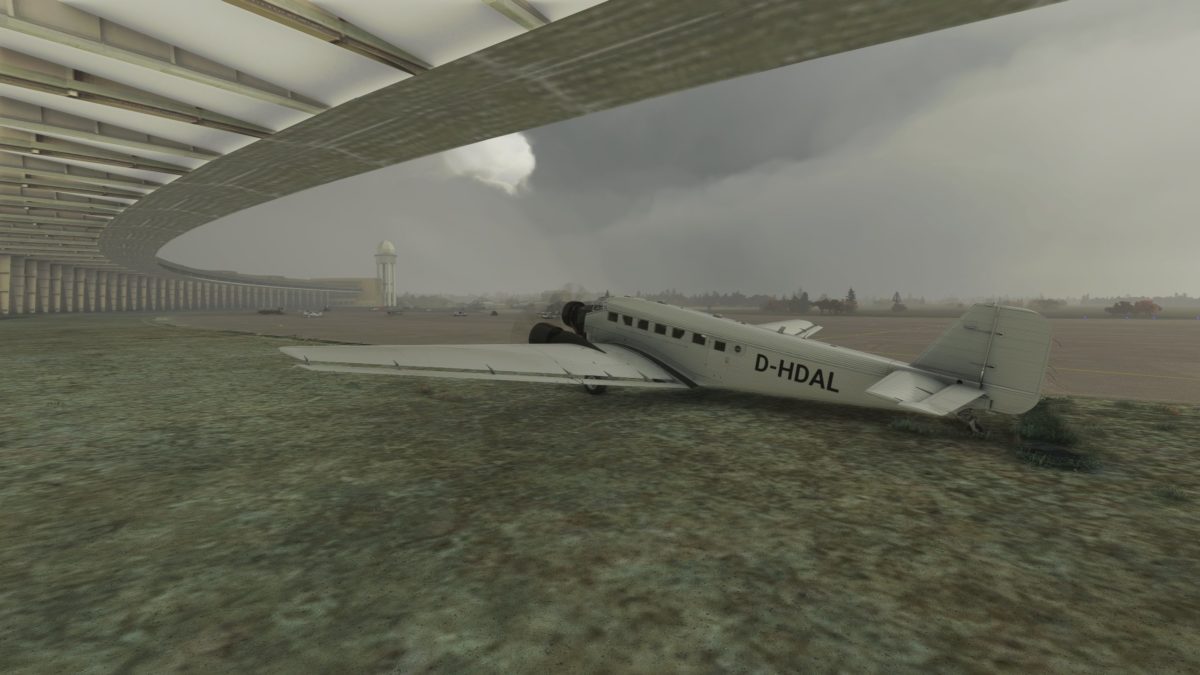
Which is why I’m here at Santos Dumont Airport in Rio de Janeiro, to explore another facet of the Ju 52 story.
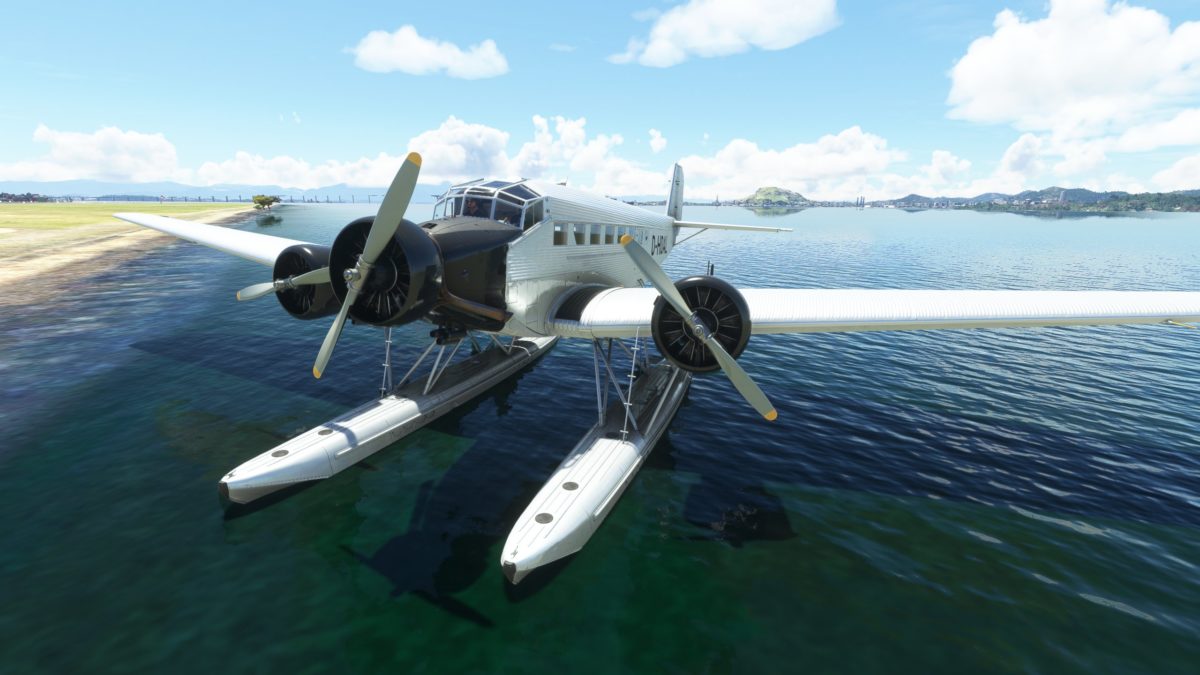
In the 1930s, Luft Hansa expanded to establish air mail and passenger service across the Atlantic from Africa to Rio.
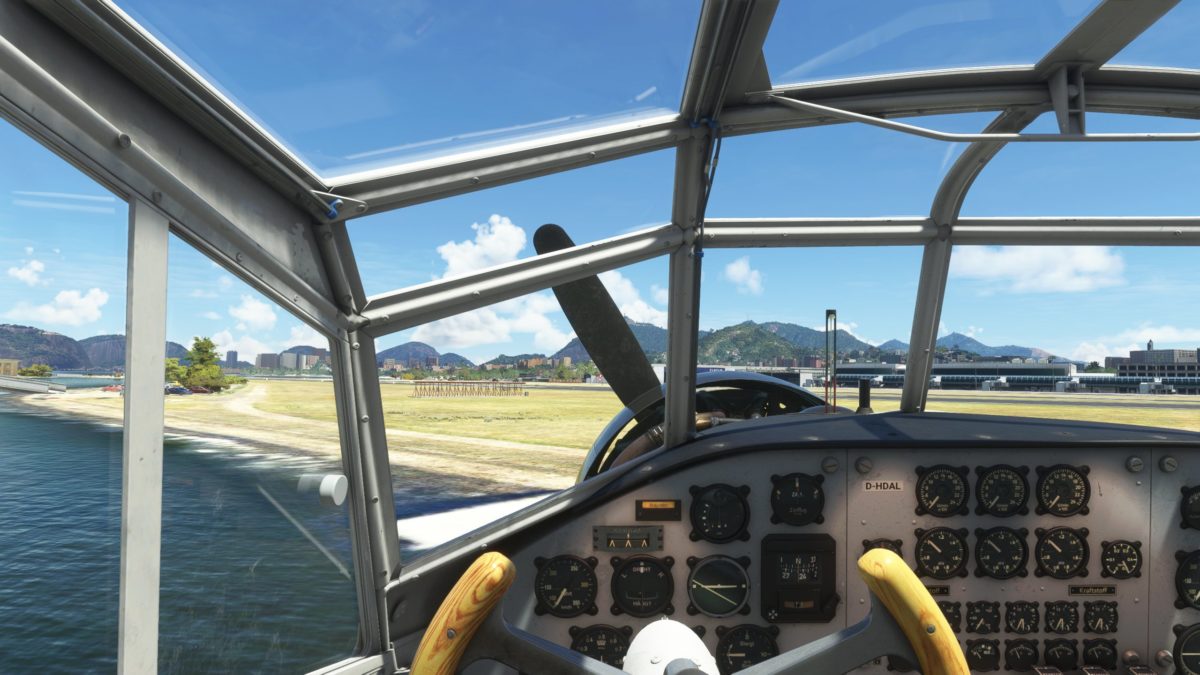
They used larger seaplanes built by Dornier to cross the Atlantic, but used Ju 52s on floats for shorter ferry service from Rio, as a hub, to other coastal cities in Brazil and down to Uruguay and Argentina.
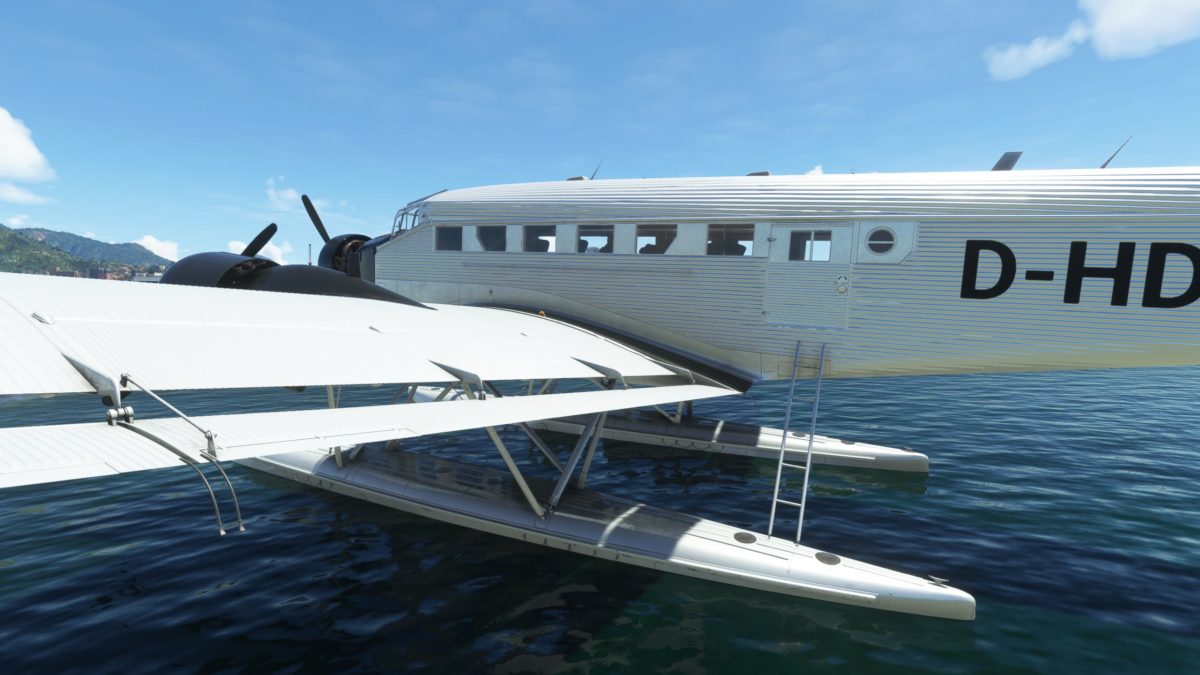
As I mentioned in my thread on the Grumman Goose, floatplanes played an important role in the 1930s as air travel expanded faster than land-based airports could to accommodate it.
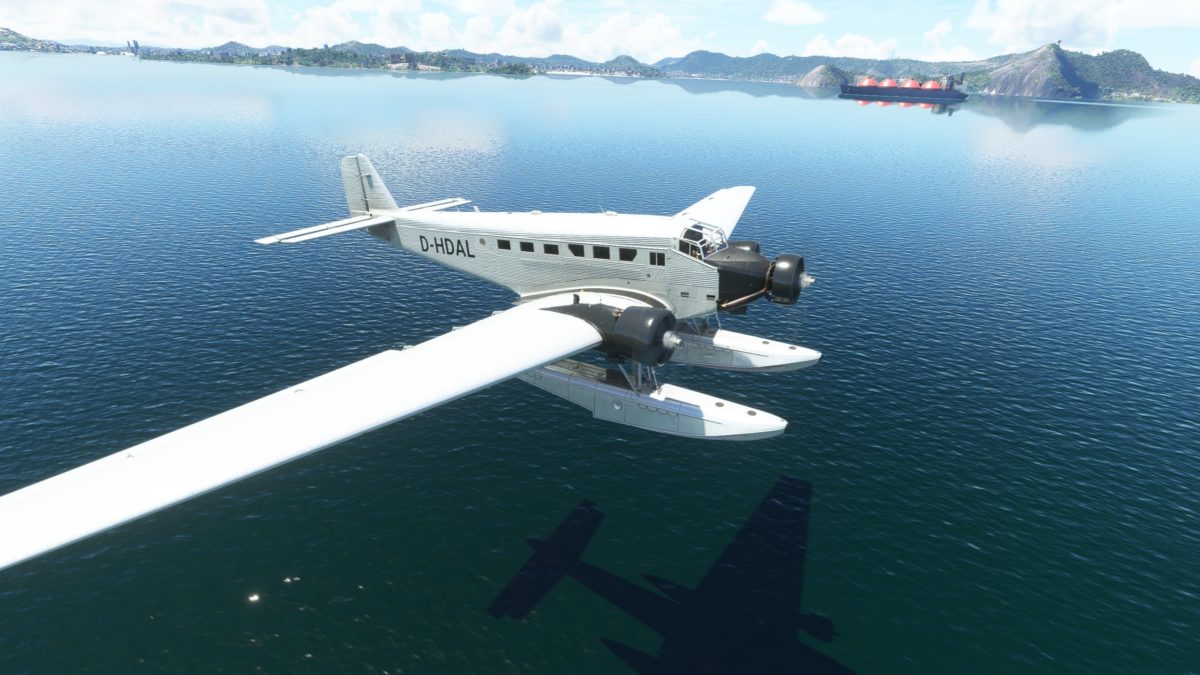
While floats only added that much more drag to the Ju 52, at least you didn’t need an airport to land.
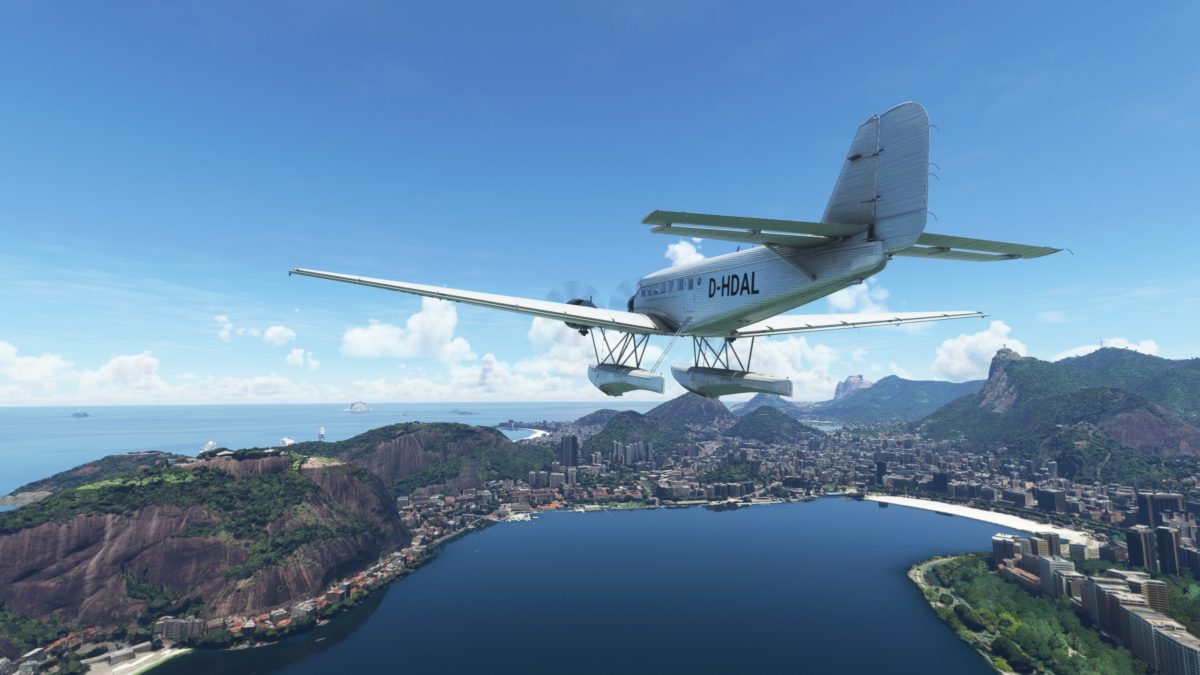
Enough history … now sit back and enjoy the sights of Rio de Janeiro.
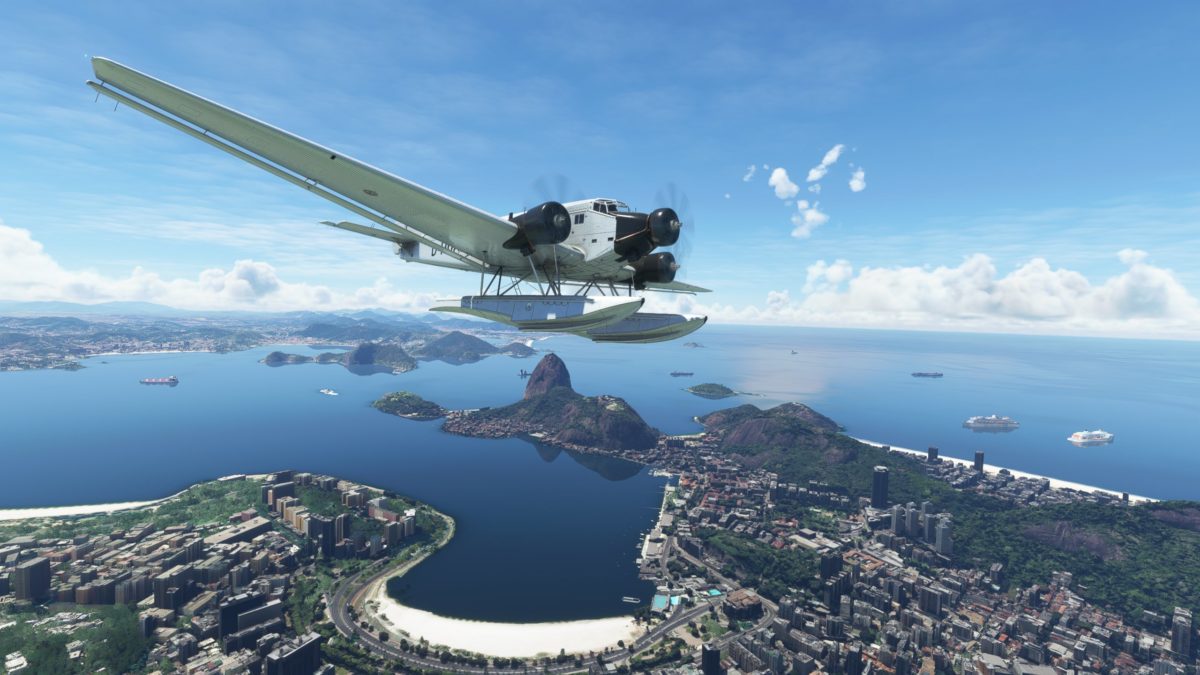
Rio’s Christ statue outside my co-pilot’s window. Complete in 1931, it would have been there for passengers in the Ju 52 to see.
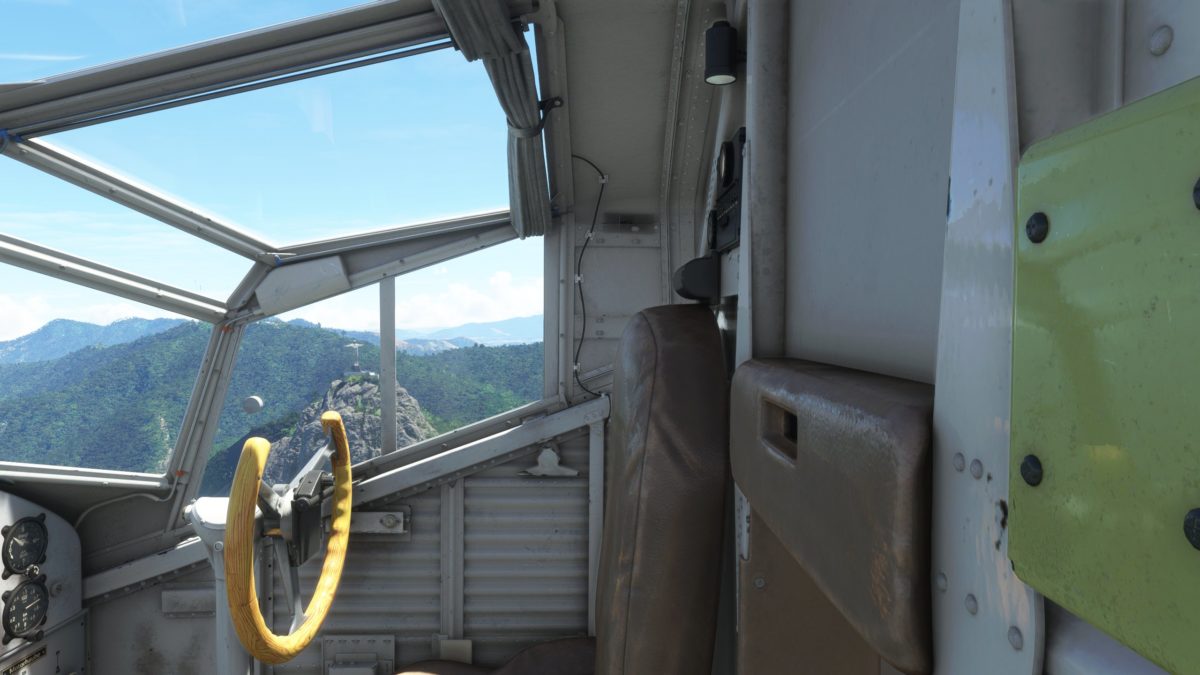
Christ the Redeemer, with downtown Rio spread below it.
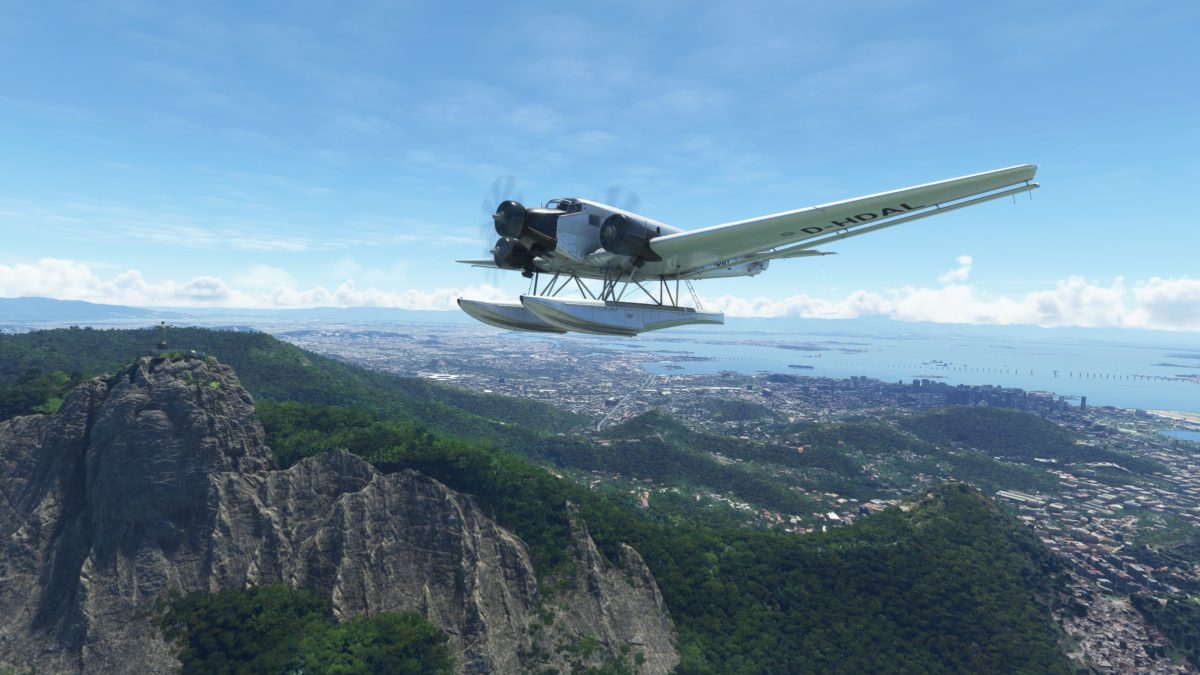
Coming around over Lagoa towards Copacabana.
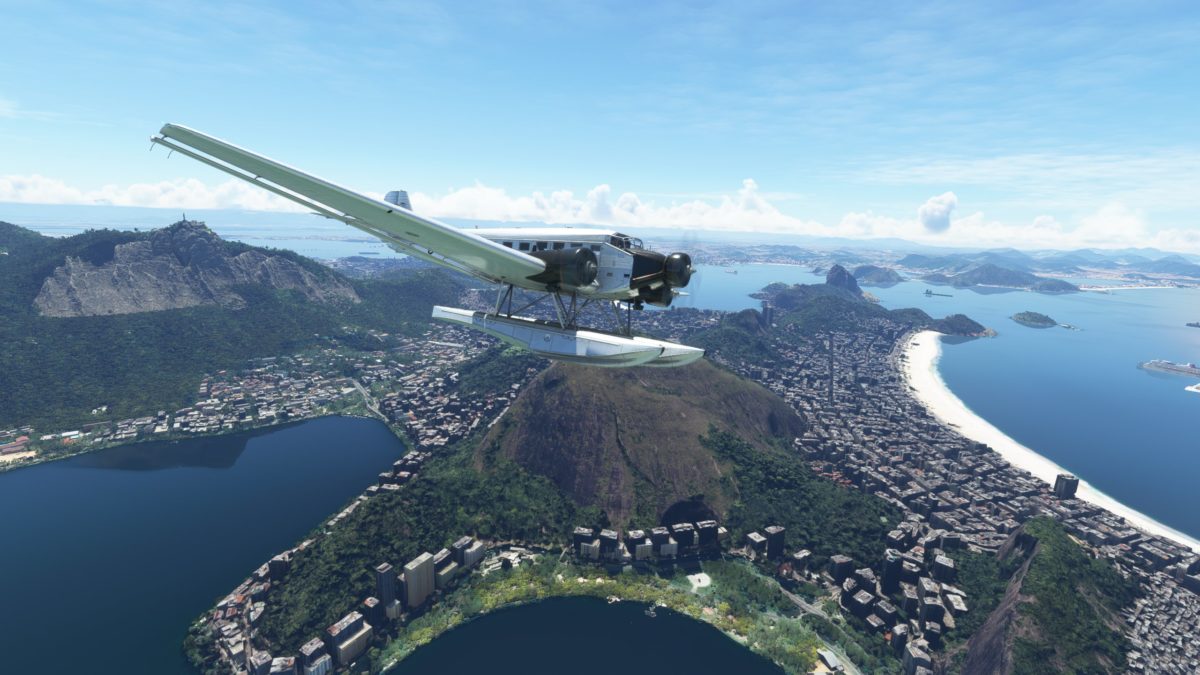
The beach at Copacabana, with Sugarloaf behind it.
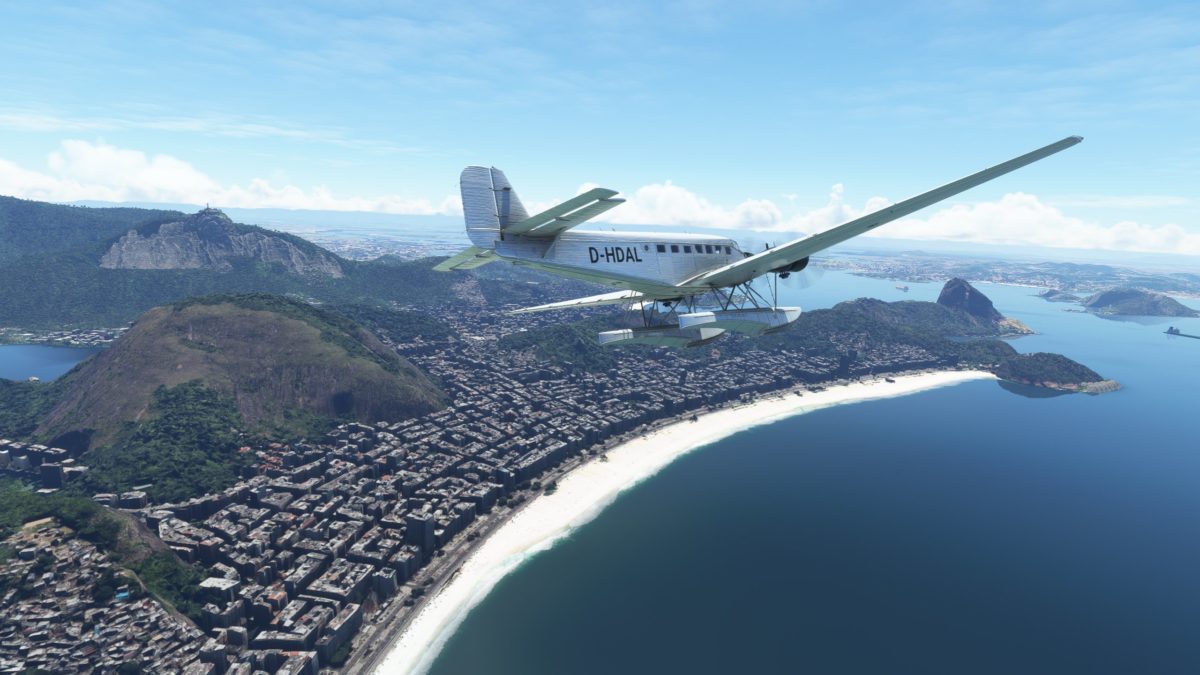
Another view of Copacabana.
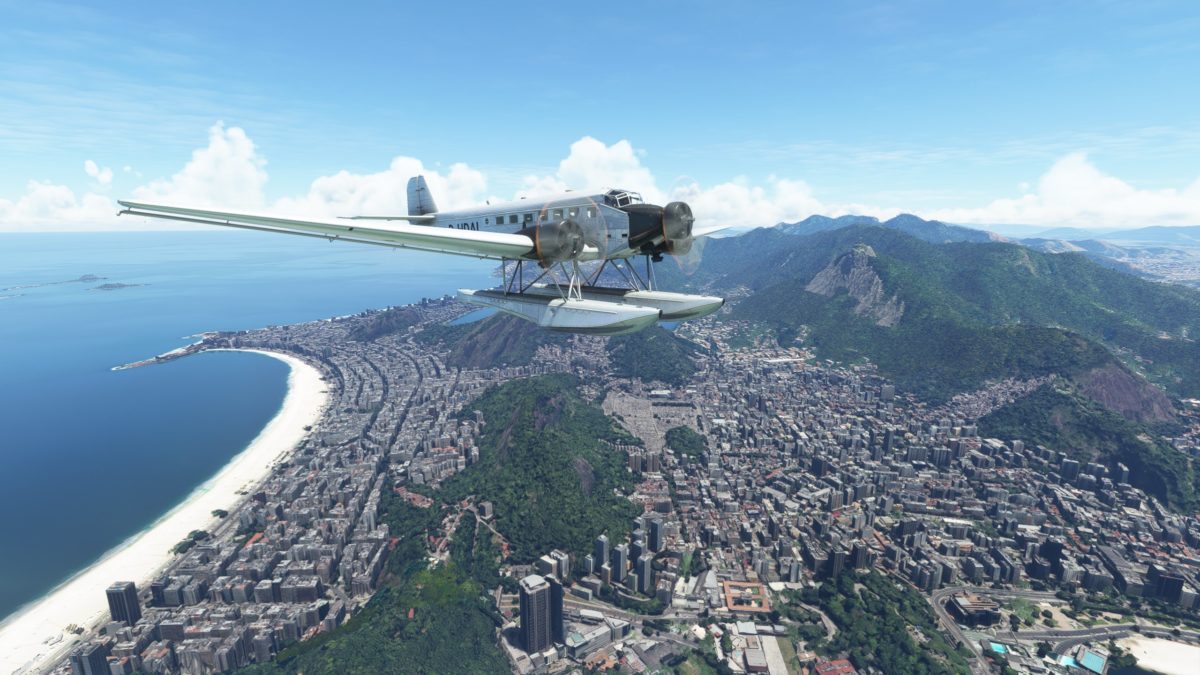
Taking a turn around Sugarloaf and starting my climb.
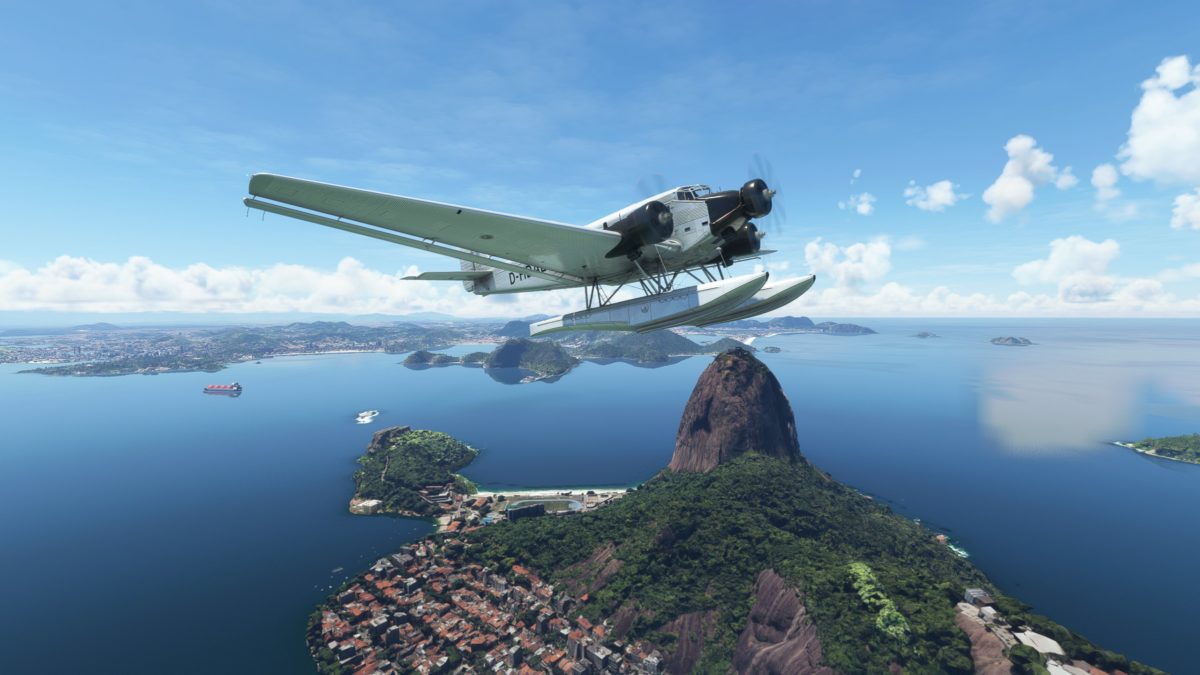
And departing the area to the south, over Ipanema, bound for … Santos? Montevideo? Buenos Aires?

Well, hope you enjoyed this look at the Junkers Ju 52, one of the world’s first modern airliners, an amazing airplane sadly co-opted for evil purposes.
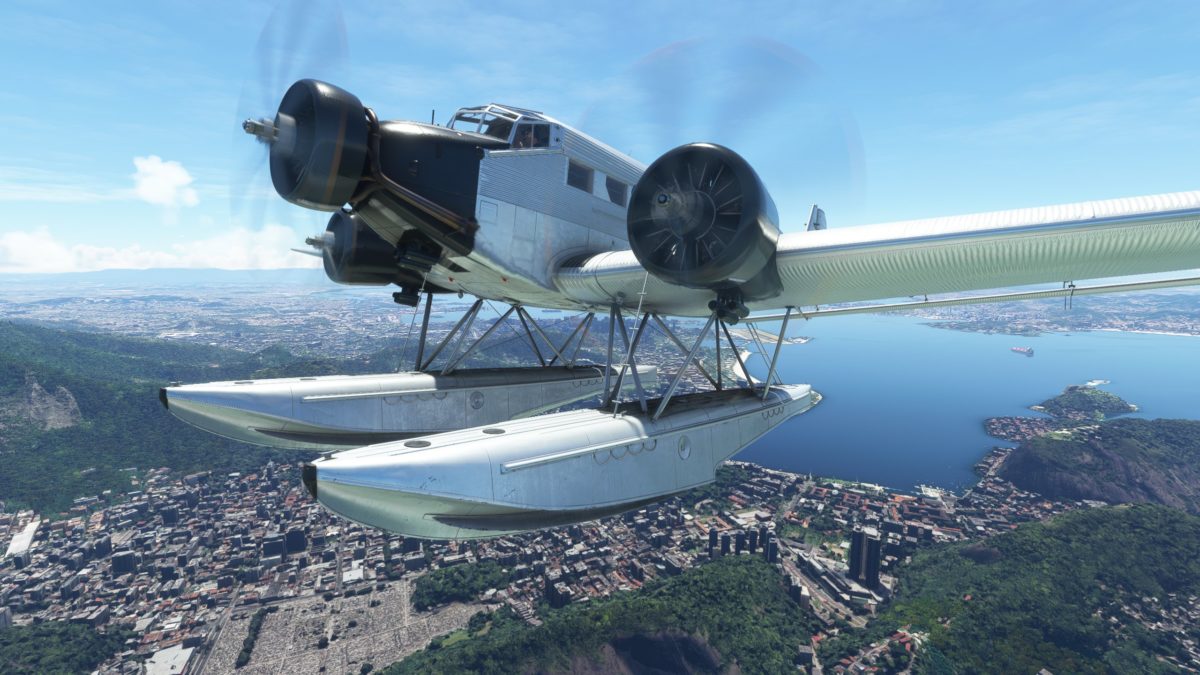
There are several Ju 52s still flying today. One of the tragically crashed in 2018 on a sightseeing flight in the Alps. Here’s an interesting video on the results of the crash investigation:
Leave a Reply